- More to Explore
- Series & Movies
Published Apr 10, 2024

A Brief History of the Progenitors in Star Trek
They designed life itself!
SPOILER WARNING: This article contains story details and plot points for Star Trek: Discovery 's "Red Directive ."

StarTrek.com
Captain Burnham's top-secret mission in the final season of Star Trek: Discovery has finally been revealed. But this time, the Discovery crew isn’t stopping a future-destroying A.I., or a lethal, extra-galactic force. Instead, they’re investigating the basic mysteries of why most species in the Star Trek universe look vaguely human.
As revealed in " Red Directive ," the search for technology used by ancient "Progenitors" sets-up a massive treasure hunt for the season. But, who are the Progenitors? What did Jean-Luc Picard know about the secrets of inter-species alien DNA? And how does all of this fit in with Gene Roddenberry’s earliest ideas for Star Trek ?
Here’s a brief history of the Progenitors, from the early 1960s, to the 24th Century, all the way to 2024, and the 31st Century.
The Real World-Origins of the Progenitors

"The Cage"
When the U.S.S. Enterprise first set out to seek out "new life and new civilizations," a huge swath of those alien lifeforms turned out to look a lot like human beings. And the primary reason for that, at least behind-the-scenes, was two-fold.
First, human actors are more affordable, and second, Gene Roddenberry wanted the classic Star Trek to avoid the sci-fi trope of "Bug-Eyed Monsters." And so, in one of the original 1964 pitch documents for Star Trek , Roddenberry floated the idea of "The Parallel Worlds" concept . The idea was that the format of Star Trek — from a writing and production standpoint — would generally deal with "...plant and animal life, plus people, quite similar to Earth. Social evolution will also have interesting points of similarity with ours."
Unlike a huge swath of science fiction on TV at the time, the promise of strange, new worlds, that were, in fact, populated by people , is something that set Star Trek apart, and was the cornerstone of what gave the series its humanist angle. But, the side effect of course, was an in-universe question — why were so many aliens humanoid?
The Old Ones, Sargon, and The Preservers

"The Paradise Syndrome"
The first two seasons of The Original Series are sprinkled with hints that, in the distant past, the galaxy was visited by super-powered aliens with technology far more advanced than anything in the Federation.
In " What Are Little Girls Made Of? ," we meet Ruk, an android built by "The Old Ones," an alien race capable of creating humanoid androids that were basically immortal. In " Return to Tomorrow ," the disembodied soul of Sargon, refers to humanity as "my children." While Dr. Muhuall says this idea flies in the face of evolutionary theory, Spock mentions the idea that aliens seeded life would "explain certain elements of Vulcan pre-history."
Then in Season 3, in " The Paradise Syndrome ," Bones and Spock tackle the question head-on. When they realize an ancient race of "Preservers" helped various humanoid species throughout the galaxy, the idea of an ancient alien race guiding and "seeding" a ton of humanoid species became less of a myth and more of a working theory. "I’ve always wondered why there were so many humanoids scattered through the galaxy," Bones says. To which Spock replies, "So have I. Apparently, the Preservers account for a number of them."
And then, the questions about an ancient humanoid species went answered. At least, until The Next Generation .
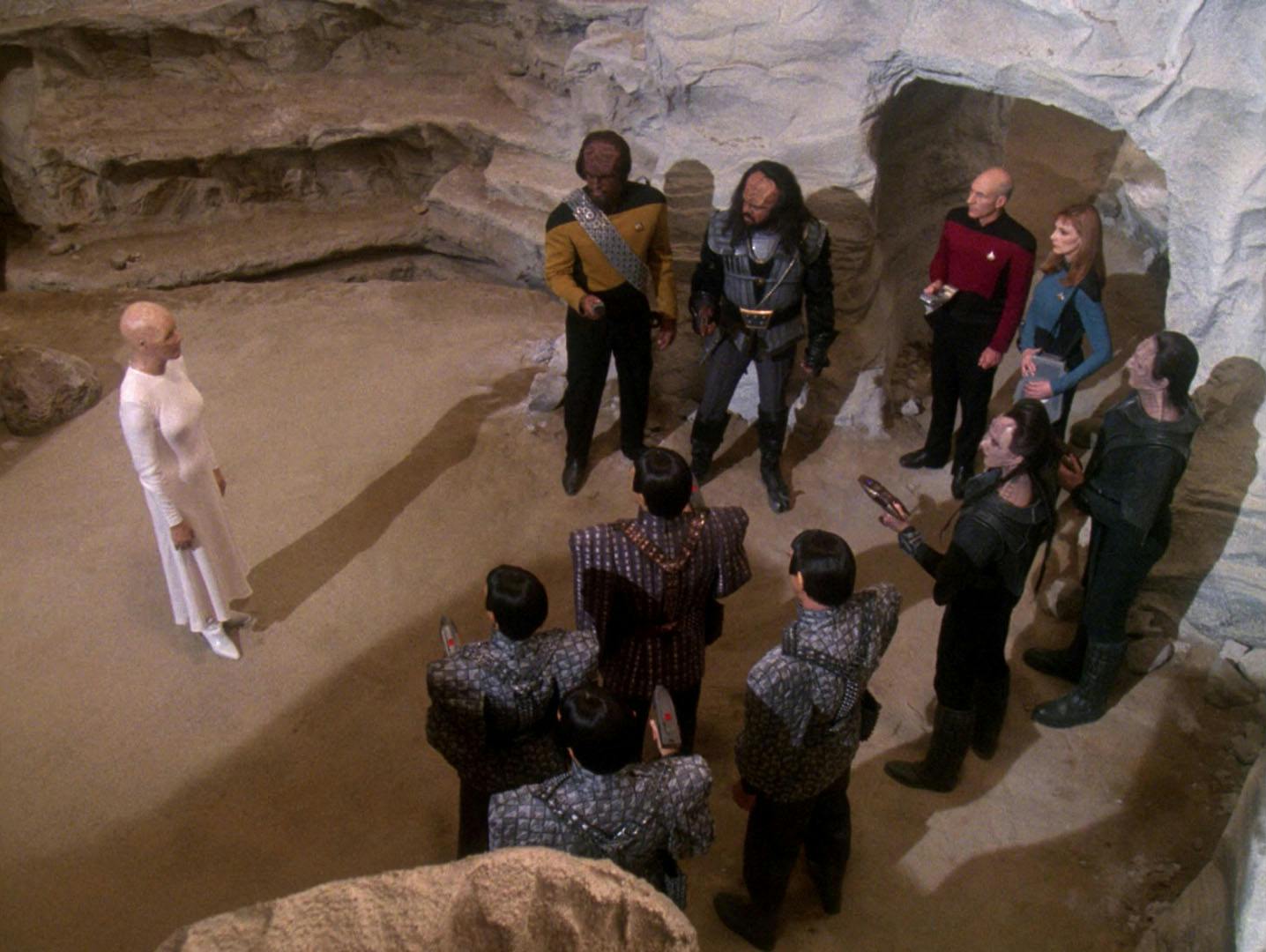
"The Chase"
Directed by Jonathan Frakes and written by Ronald D. Moore and Joe Menosky, " The Chase " was a sixth-season episode of The Next Generation , which, according to The Next Generation Companion , was considered in the writers' room the most "Roddenberryesque" episode of TNG at that time. The story itself took cues from Carl Sagan's novel Contact , and posited that yes, ancient aliens not only seeded most of the humanoid species, but also hid a message in the DNA of all those species.
Captain Picard's interest in archeology comes in handy during the quest to locate all the DNA strands and reveal the message, which was also represented metaphorically by the ancient artifact known as the Kurlan naiskos .
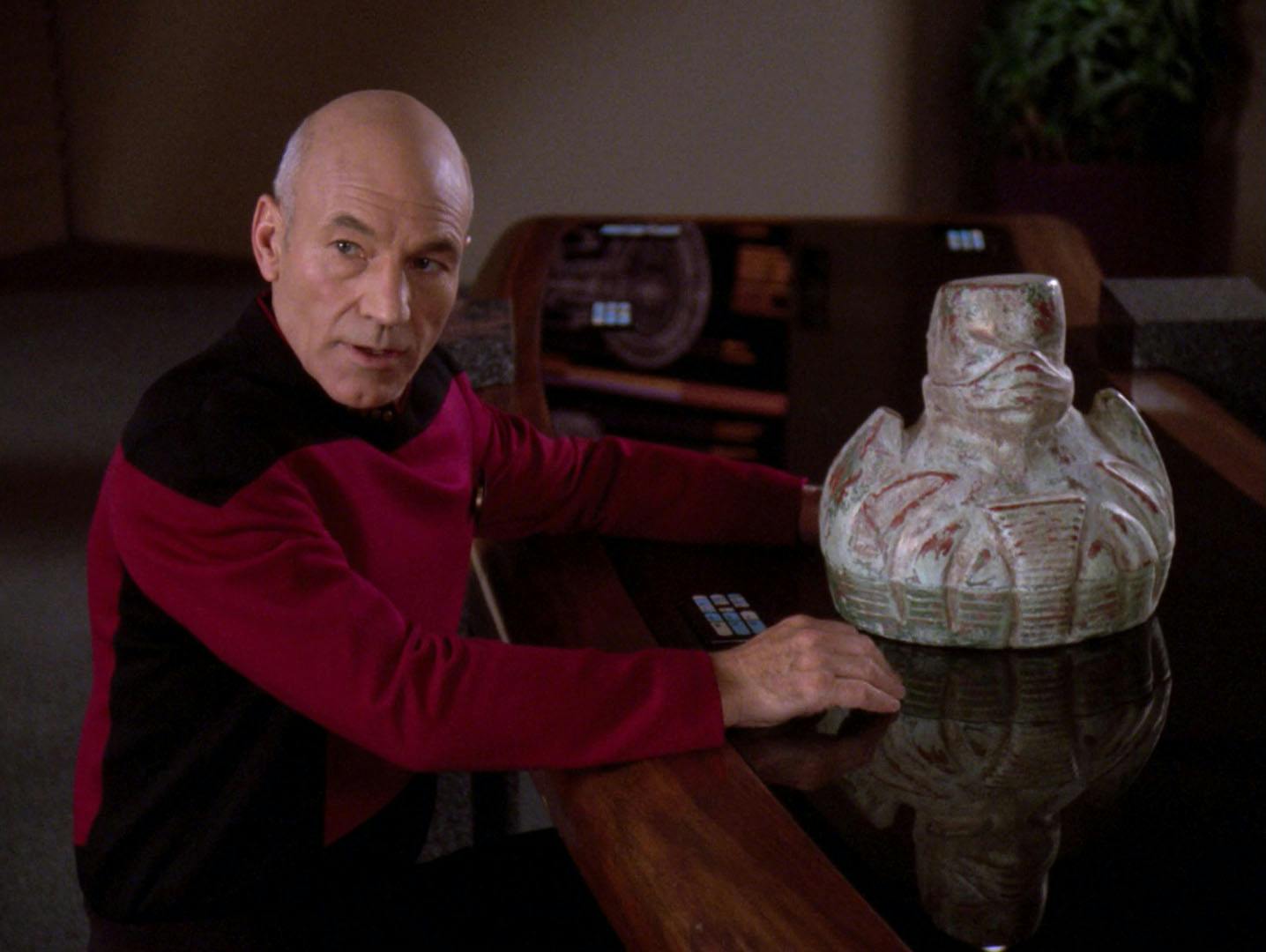
At the end of the episode, representatives from the Klingon Empire, the Romulan Empire, the Cardassian Union, and the Federation, all witness the truth — an ancient Progenitor (played by Salome Jens) makes it clear that all the humanoid species in the galaxy don’t exist out of pure hubris, but instead, out of a kind of desire for legacy. "You are a monument, not to our greatness, but to our existence…. Remember us."
Ronald D. Moore pointed out that there's no reason to believe that the Progenitors from "The Chase" and the Preservers from TOS aren't one in the same. Though not explicitly stated in the script, he said, "But this could be them, and be internally consistent."
Discovery Brings It All Home
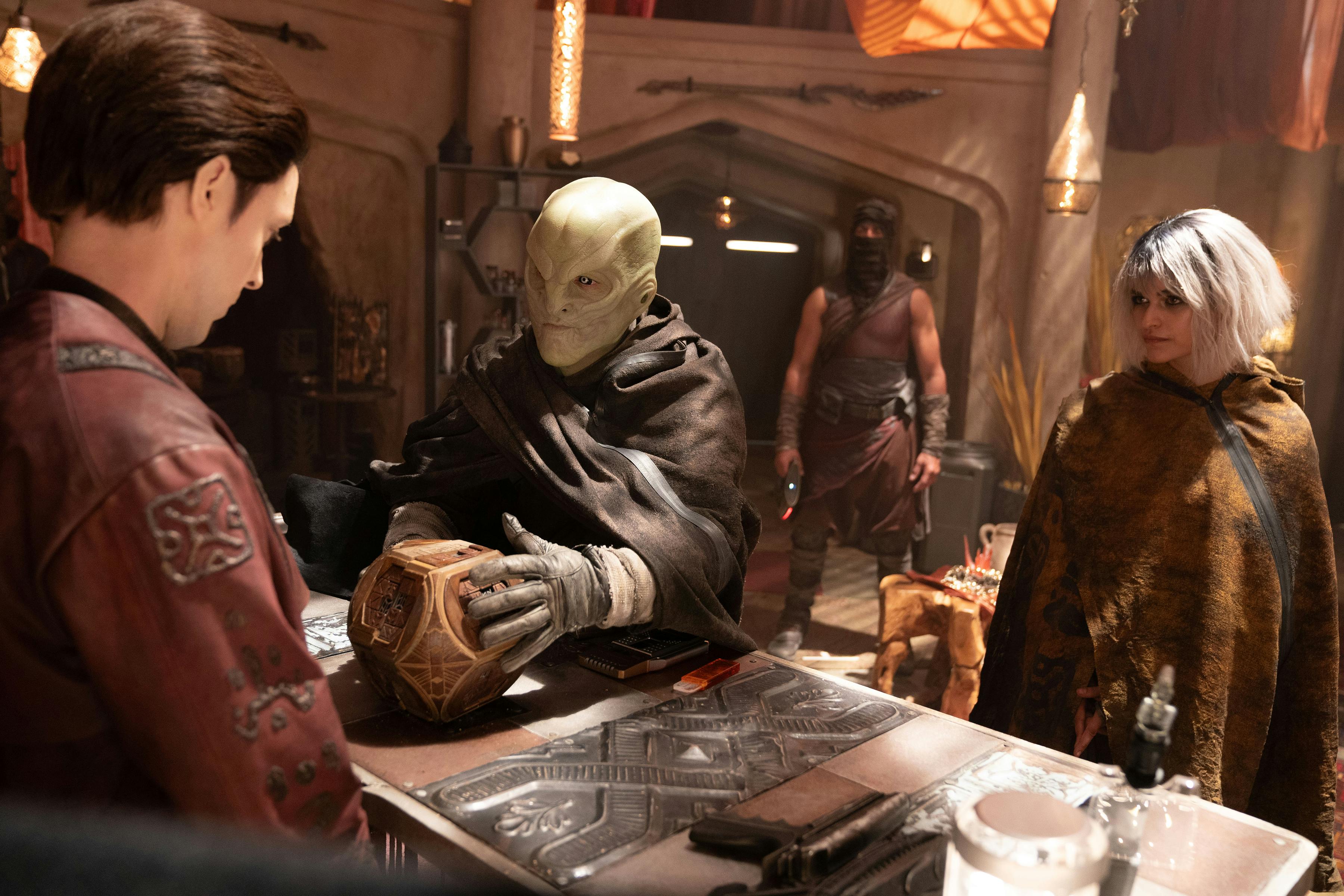
"Red Directive"
While The Next Generation established a canonical fact that TOS only danced around, that only answered the question of why . With Discovery Season 5, a stranger, and more complex question is getting broached — how ?
"The Chase" told us why there are so many humanoid species in the galaxy, but we had no idea how the Progenitors specifically pushed life to evolve on various planets toward the exact form of life we’re all so familiar with. As the crew of Discovery — and other forces — are in pursuit of this ancient tech, Star Trek is boldly speculating on one of the biggest questions of all time.
If there was a supreme intelligence behind the creation of life, what was their method? While these kinds of questions are somewhat mind-boggling in real life, what Discovery is doing now is what Star Trek has done all along: Ask provocative questions that are beyond what we know now, so that maybe, in the future, we’ll be better prepared.
We don’t know that the Progenitors exist in real science, but the "panspermia hypothesis," is a very real scientific concept. A friendly alien may not have consciously sparked life on Earth eons ago, but, in reality, it is possible that some building blocks for life itself may have come from the stars.
Get Updates By Email
Ryan Britt is the author of the nonfiction books Phasers on Stun! How the Making and Remaking of Star Trek Changed the World (2022), The Spice Must Flow: The Journey of Dune from Cult Novels to Visionary Sci-Fi Movies (2023), and the essay collection Luke Skywalker Can’t Read (2015). He is a longtime contributor to Star Trek.com and his writing regularly appears with Inverse, Den of Geek!, Esquire and elsewhere. He lives in Portland, Maine with his family.
Star Trek: Discovery Seasons 1-4 are streaming exclusively on Paramount+ in the U.S., the UK, Canada, Switzerland, South Korea, Latin America, Germany, France, Italy, Australia and Austria. Seasons 2 and 3 also are available on the Pluto TV “Star Trek” channel in Switzerland, Germany and Austria. The series streams on Super Drama in Japan, TVNZ in New Zealand, and SkyShowtime in Spain, Portugal, Poland, The Nordics, The Netherlands, and Central and Eastern Europe and also airs on Cosmote TV in Greece. The series is distributed by Paramount Global Content Distribution.
- Star Trek 101

- Lower Decks
- Short Treks
- Strange New Worlds
- Deep Space Nine
- Star Trek: Picard
- The Next Generation
- The Original Series
UPDATED: Star Trek Books 2024
Star trek’s lost original enterprise model returned, classic star trek alien in star trek: section 31, star trek renewal news – cast & creatives respond, new: strange new worlds – scotty is on board for season 3, review star trek: discovery season 5 episode 7 “erigah”, review – star trek: discovery season 5 episode 6 “whistlespeak”, review – sons of star trek #2, review – star trek: discovery season 5 episode 5 “mirrors”, review – star trek: defiant #14.
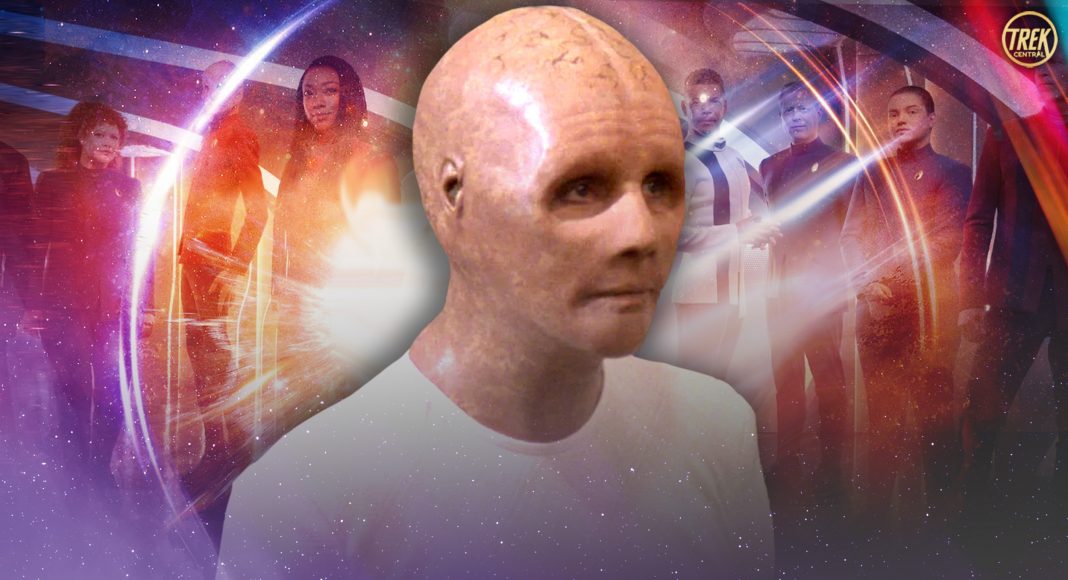
Who Are Star Trek’s Progenitors?

There’s been a lot of whispering about ancient powers and long-lost puzzles in Star Trek lately. Star Trek: Discovery’s Season 5 ramped it up with a new treasure hunt for an ‘ancient power’, later teased by franchise boss Alex Kurtzman as a major The Next Generation (TNG) Easter Egg. And that ancient power has now been revealed! Star Trek’s Progenitors, an ancient race of humanoids from TNG episode ‘The Chase’. And while there are many old, even god-like beings in the Star Trek universe, unlike the Q Continuum, Star Trek ‘s Progenitors aren’t gods. They’re just regular aliens who developed long before any other intelligent life.
SPOILER WARNING – This article does not give any major spoilers for Star Trek: Discovery’s Season 5 premiere episodes. However, it is related to the storyline and the teased TNG Easter Egg.
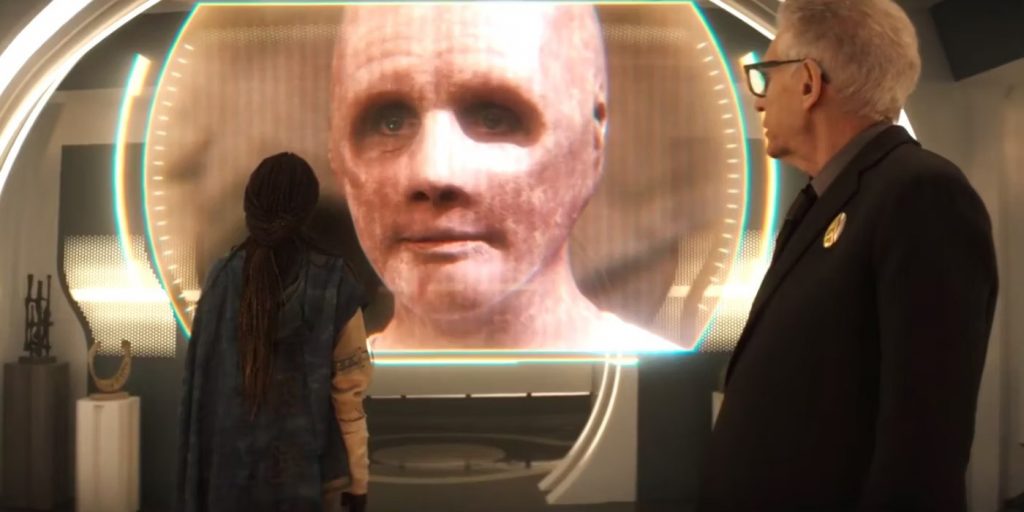
The Progenitors have remained shrouded in mystery, never really touched on again. Now they’re back and their legacy and technology are key to the final season of Star Trek: Discovery . The Progenitors may have changed the universe forever, but what did they do? What do we know about these mysterious aliens? And what can they tell us about where Discovery Season 5 could be going? Let’s delve into Star Trek ‘s oldest aliens, the mysterious Progenitors!
Captain Jack explores Star Trek’s first aliens – the Progenitors – in depth in Trek Central’s latest video.
These ancient humanoids originate from an episode of Star Trek: The Next Generation , “The Chase” . The episode saw the USS Enterprise-D pick up a biological puzzle from the late Professor Galen ( Norman Lloyd ). It sounds like a standard set-up for a TNG episode, but in the end, the result was anything but. The revelation would have a massive impact on Star Trek canon. It is also the episode where Captain Picard ( Sir Patrick Stewart ) was gifted the Kurlan naiskos, a prop that would accompany him into Star Trek: Picard .
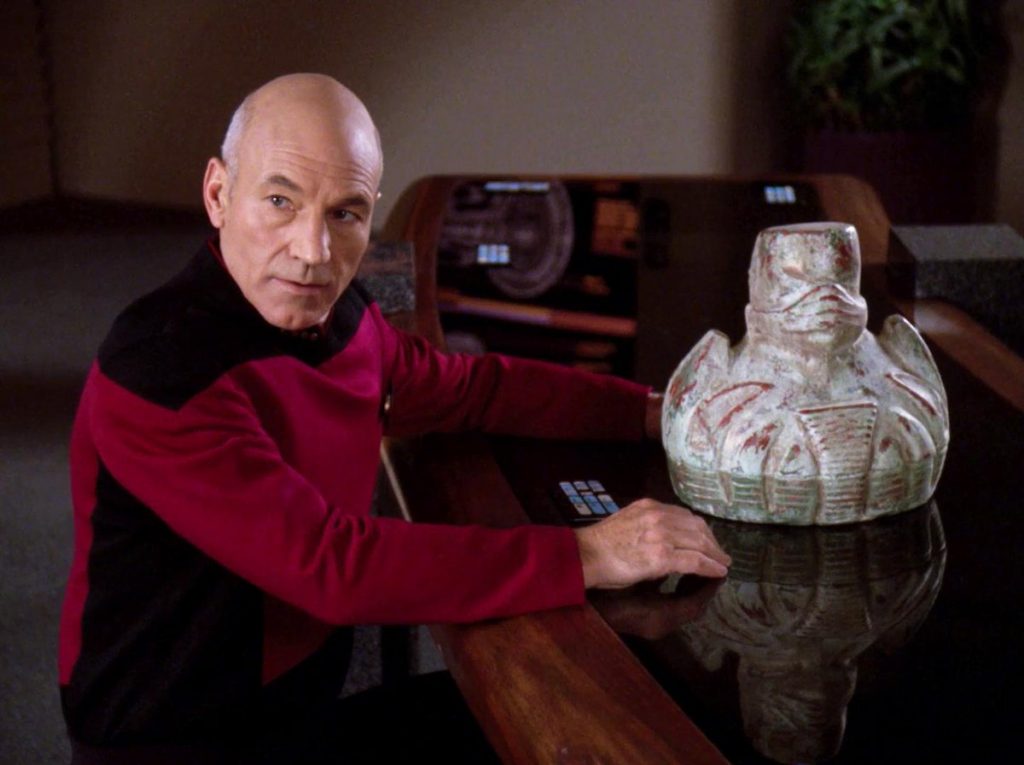
Galen found DNA links between 19 species across the quadrant. These protein blocks had existed on each planet for as long as its life had. It’s also proven that this was a kind of program, not a natural formation or coincidence. Whatever this was, it was designed over four billion years ago by a civilization far older than anything the Federation had ever encountered before.
“…it could be the most profound discovery of our time, or the most dangerous.” Captain Jean Luc Picard – ‘The Chase’ (The Next Generation)
Professor Galen and Picard understood this was the most profound scientific discovery of the 24th Century. However, it could also be the most dangerous if the information got into the wrong hands. Tensions only escalated when the USS Enterprise-D ran into Cardassians, Klingons, and Romulans, who were also investigating this connection. Through an uneasy alliance, the group decoded a message from the Progenitors.
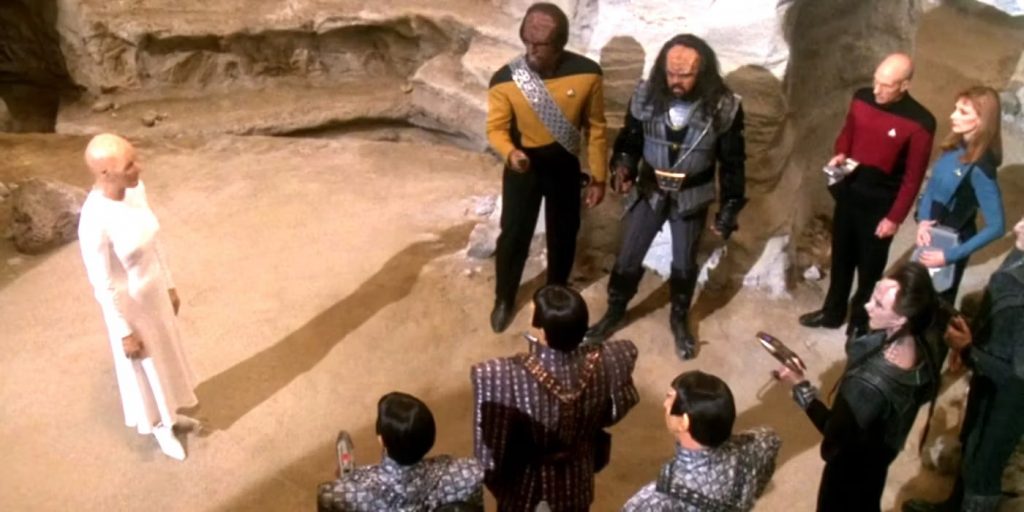
Star Trek’s Progenitors only appear through a holographic message from an ancient humanoid alien ( Salome Jens ). They confirm that their race evolved long before all other life in the Universe. In an attempt at longevity, they seeded oceans where life was in its infancy. Basically, they played god. It’s never explicitly confirmed, but it’s heavily implied this species is now extinct. The genetic code connection is, in effect, is their only lasting legacy.
The message ends with the line, “There is something of us in each of you, and so, something of you in each other” . This prompts a furious response from the Cardassians and Klingons, who couldn’t stand the idea of being related to their enemies. Interestingly, however, the Romulan captain and Picard share a dialogue, hoping that the Federation and the Romulan Empire could one day stand together in friendship.
This revelation of all the major Star Trek aliens being biologically connected to each other was never expanded on. Federation relations with the Cardassians and Romulans didn’t change in the slightest. It appears that this discovery then was probably covered up, leaving it to future generations to pick up the pieces. Who knows what kind of power one could wield or the technology one could develop with that kind of knowledge? With their technology being the basis for the latest season of Discovery , only time will tell!
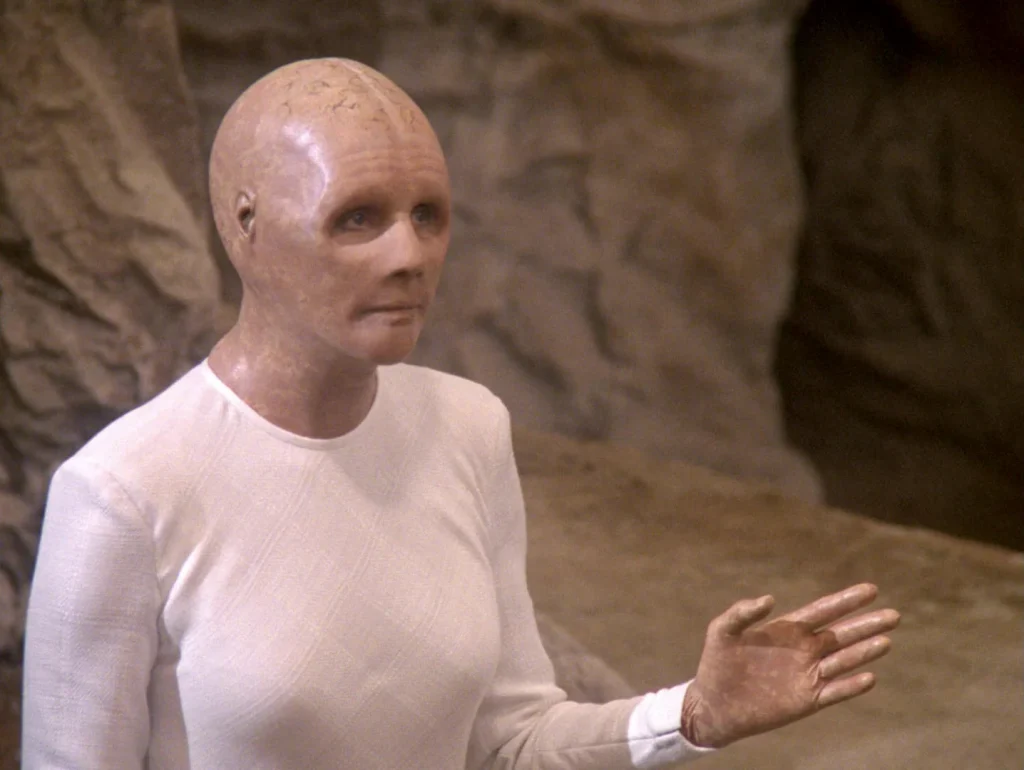
Where will the trail lead?
So that’s everything we know about the mysterious Progenitors so far. Until now, they have only made a single appearance in Star Trek . Albeit, one with massive implications for the universe. The idea of all Star Trek ‘s well-known species being related is one that was begging to be picked up. I’m really looking forward to seeing how this story develops over the course of Star Trek: Discovery Season 5. It is definitely a very exciting easter egg to base the latest season on.
Captain Burnham and her crews uncover a mystery that sends them on an epic adventure across the galaxy to find an ancient power whose very existence has been hidden for centuries . Star Trek Discovery Season 5 – Official Synopsis
The synopsis for Star Trek: Discovery Season 5 mentions finding an ancient power that has been hidden for centuries . It appears the scientific discovery revealed in TNG’s ‘The Chase’ was indeed covered up. Assuming, of course, that this refers to what the Progenitors did. While there could be another twist around the corner, ‘Red Directive’ and ‘Under the Twin Moons’ center this idea as the basis for the season’s story. I’m definitely looking forward to seeing how they build on this exciting piece of Star Trek lore!
Star Trek: The Next Generation and Star Trek: Discovery stream on Paramount+, plus Netflix, SkyShowtime, and TVNZ. Check your local programming for where to watch . For more Star Trek lore discussions, theories, reviews, and more , follow the team here at Trek Central!
More From Trek Central
- 🚨 – REVIEW – Star Trek: Discovery Season 5 Episode One & Two
- 🔥 – MULTIPLE Star Trek Movies In Development!
- 🔍️ – Religion in Star Trek
Join the Star Trek conversation via our social media platforms:
- Facebook – https://www.facebook.com/TrekCentral
- Instagram – https://instagram.com/TrekCentral
- Twitter – https://twitter.com/TheTrekCentral
- YouTube – https://youtube.com/TheTrekCentral
- Mastodon – https://mastodon.social/@[email protected]
- Discord – https://discord.gg/fF2heMbfW8
- Star Trek Discovery
- Star Trek The Next Generation
- Star Trek: Discovery Season 5
- The Progenitors
more star trek 🖖
the latest 🚀
- Privacy Policy
- Cookie Policy
Trek Central is not endorsed, sponsored, or affiliated with ViacomCBS / CBS Studios Inc or the STAR TREK Franchise. All STAR TREK trademarks, logos and images © CBS Studios Inc.
© 2019–2023 Redwood Media LTD
Star Trek: Discovery's Season 5 Reveal Is the Craziest Twist the Franchise Has Ever Attempted
Star Trek: Discovery's final season is picking up from a franchise-changing, long-ignored plot point introduced in the franchise over 30 years ago.
- Season 5 of Star Trek: Discovery picks up on a long-forgotten storyline from The Next Generation involving a common genetic origin for various species.
- The crew of the Discovery is on a mission to uncover ancient technology left behind by the Progenitors, creators of life in the universe.
- This final season aims to explore themes of creation and purpose, tying up loose ends while reflecting on a united future for various species in the Star Trek universe.
This article contains MAJOR Spoilers for Star Trek: Discovery season 5.
Star Trek: Discovery Season 5 kicked off in a big way. After a two-year hiatus after Season 4 concluded in 2022, Star Trek: Discover y is finally back on Paramount+ for its final season. The series debuted back in 2017 as the flagship series for the streaming network, then known as CBS All Access. Star Trek: Discovery originally was a prequel series to Star Trek: The Original Series set in the year 2256, but the Season 2 finale saw the crew of the USS Discovery jump forward in time to the year 3188, the furthest point in the Star Trek timeline on screen and has explored a new era for the franchise.
Star Trek: Discovery Season 5 debuted on Apr. 4, 2024, with a two-part episode. The premiere date was timed one day before First Contact Day , an informal but fan celebration of the Star Trek franchise, which in the universe of the series marks the day that humans make first contact with an alien species, the Vulcans. While the premiere date being close to First Contact Day was a nice way to celebrate, the final moments show that the date might have been a deliberate choice as it ties in with Star Trek: Discovery 's shocking twist as the first episode of the season "The Red Directive" ends with the revelation that is following up a storyline from The Next Generation that no other entry in the franchise has.
What Was the Twist in Star Trek: Discovery?
Star trek: discovery.
Read Our Season 5 Review
Star Trek: Discovery Season 5, Episode 1, "The Red Directive," featured Captain Burnham (Sonequa Martin-Green) and the crew of Discovery being tasked with securing an unknown artifact that is important to the Federation. By the end of the episode, it is revealed that the secret treasure they have been chasing this whole time is, in fact, the diary of a Romulan scientist named Vellek. Vellek is retconned to be a background character from the iconic Star Trek: The Next Generation episode "The Chase" and reveals that the major plot of Star Trek: Discovery Season 5 will be about following up on that storyline.
Burnham learns about The Progenitors, a previously unnamed race from The Next Generation episode "The Chase," and discovers that they were the creators of sentient life in the universe and an explanation for why the various aliens in the Star Trek franchise all have humanoid features. This sets up the storyline for Season 5, as the crew is now tasked with locating the Progenitors' ancient technology, which could be the key to creating life.
This sets up the final season. Unlike previous seasons with a season-long mystery, Star Trek: Discovery Season 5 has revealed the major revelation up front to set up an adventure described as an "Indiana Jones season" by star Sonequa Martin-Green . Just like Star Trek II: The Wrath of Khan picks up from a storyline in the original television series, Star Trek: Discovery 's new storyline was set up years ago in a separate Star Trek series from over three decades ago.
The Chase and How It Changed Star Trek
As mentioned before, the seeds for the final storyline in Star Trek: Discovery were planted all the way back in 1993. In Star Trek: The Next Generation episode "The Chase," the 20th episode of Season 6, Captain Jean-Luc Picard (Patrick Stewart) and the crew of the Enterprise discover an ancient puzzle that is compatible with DNA strands that have been recovered from different worlds all over the galaxy. They, along with the Klingons, Romulans, and Cardassians, all get on the same page and realize that an embedded genetic pattern is constant throughout many different species.
Later in the episode, the various cultures come across a hologram from one of the ancient aliens who reveals that when their species first explored the galaxy, there was no humanoid life in the universe, so they spread their DNA around, making various species as a way to continue on their legacy. Aside from the revelation that multiple species in Star Trek , like humans, Vulcans, Klingons, Romulans, Kelpien, Orion, and Cardassians, are all descended from the same source, the episode ending hints at an optimistic future for these species. The Progenitors revealed they left clues of their existence so that when the various species they created took to the stars, they would find out the truth together and realize their shared common origin.
Star Trek: Discovery Stars and EPs on Why There Would Be No Modern Era of Trek Without Discovery
This provides an in-universe explanation of why so many aliens in the Star Trek franchise are humanoid beings, covering up the fact that the original series had a very small budget and had to work with human actors in alien costumes instead of elaborate costumes with otherworldly designs. It also was a major revelation for the franchise, confirming an intelligent creator behind life in the universe and falling into the ancient alien's theory. Despite this major revelation, Star Trek has largely ignored it. This is a major revelation that the franchise has not touched in over 30 years, but Star Trek: Discovery looks to be building on it in a major way and might be the perfect show to pick up this thread.
Why Bring It Up Now in Star Trek: Discovery
Despite the significant universe ramifications from "The Chase," no entry in the franchise has picked up on it further. Star Trek: Discovery seems almost perfectly made to pick up this plot more than any past Star Trek programs . Seasons 3 through 5 have been about the recreation of Starfleet and the United Federation of Planets. The Progentator's dream was that the various species they created would someday unite, which is the goal of the Federation. Yet, in the 31st century, it is clear that the idea of unity between planets is further than it was in The Next Generation .
Star Trek: Disocvery 's third and fourth seasons served as a reflection of the real world as the franchise has in the past. Much like how Star Trek VI: The Undiscovered Country was an allegory for the end of the Cold War, Star Trek: Discovery used the time jump and fractured Federation to comment on the growing trend in isolation and nationalism that has been sweeping the globe in the past 10 years. The world seems further away from the united utopia that Star Trek showed audiences in the 1960s.
Now, for the series' fifth and final season, the Discovery crew is tasked with facing down the ultimate question: Where do we come from? Now that they know their creators, what comes next? In the 24th century, the information was not enough to unite the world, but maybe in the 31st century, the knowledge of a common shared history will unite various species to make for an even stronger Starfleet than ever before.
Star Trek: Discovery Season 5 looks to be wanting to try and redo Star Trek V: The Final Frontier . That film was intended to be the final Star Trek adventure for the crew of the Starship Enterprise by having the crew confront the concept of God. Yet, that film was a box office and critical disaster, which resulted in one final attempt to give the original crew a more fitting farewell.
Star Trek: Discovery Season 5 now finds the crew of Discovery on a mission to find the keys to life's existence and what their purpose is, which will tie into the various characters finding out what their own purpose in life is in their final adventure together. Hopefully, this Star Trek entry which tackles the themes of creation fairs better than the previous one. Star Trek: Discovery is streaming now on Paramount+. Check out our interview with Star Trek: Discovery stars Wilson Cruz, Mary Wiseman, and Blu del Barrio below.
By providing your information, you agree to our Terms of Use and our Privacy Policy . We use vendors that may also process your information to help provide our services. This site is protected by reCAPTCHA Enterprise and the Google Privacy Policy and Terms of Service apply.
Star Trek: Discovery’s Season 5 Premiere Easter Egg Explained: Who Are the [Spoiler]?
Keisha hatchett, staff editor.
- Share on Facebook
- Show more sharing options
- Share to Flipboard
- Share on LinkedIn
- Submit to Reddit
- Post to Tumblr
- Share on WhatsApp
- Print This Page
Star Trek: Discovery co-showrunner Alex Kurtzman previously told TVLine that the sci-fi drama’s fifth and final season was dependent on a “very significant” Star Trek Easter egg , and we finally know what he meant by that.
The season’s first two episodes, which are now streaming on Paramount+, sent the Discovery crew on one last adventure to find the missing clues spread throughout the galaxy that will lead them to the ancient device used by an ancient species, known as the Progenitors, to create life as we know it.
That Easter egg came into play in the premiere , as outlaws Moll ( Agents of S.H.I.E.L.D.’s Eve Harlow) and L’ak ( Shadowhunters ’ Elias Toufexis) stole a tan zhekran — a traditional Romulan puzzle box; Narek (Harry Treadaway) used one as a thinking aid in Star Trek: Picard Season 1 — from an 800-year-old Romulan science vessel.
The Federation was also heavily invested in finding this mystery box, and Dr. Kovich and Admiral Vance remained tightlipped while briefing Burnham on a secretive mission to retrieve it. Captain Burnham nearly caught Moll and L’ak aboard the science vessel but they escaped to the Dune -like planet Q’mau.
There, the fugitive duo convinced a Synth dealer named Fred to open the box under the guise of selling it along with other timeless treasures, including a self-sealing stem bolt (frequently mentioned throughout Star Trek: Deep Space Nine , though their specific use is unclear) and an old tricorder (a hand-held sensor issued by Starfleet that can be used for scanning, recording and analyzing data).

Dr. Vellek found the ancient humanoids’ life-creating device and recorded everything he knew about it in that diary. He then hid the device sometime before disappearing 800 years ago, and the diary contains important clues — such as the drawing of two moons — to find it.
Book and Burnham tracked Moll and L’ak to Q’mau, where they came upon Fred’s lifeless body. As they continued pursuing the outlaws, Culber, Stamets and Saru examined Fred aboard Discover y and realized that he was built from one of Dr. Soong’s designs.
Dr. Noonien Soong (Brent Spiner) created several android prototypes, including Data, Lore and B-4 — all portrayed by Spiner throughout TNG’s seven-season run.
L’ak and Mall again evaded Burnham & Co., but not before starting a catastrophic avalanche that forced the Discovery captain and a frustratingly aggressive Captain Raynor ( The Umbrella Academy’s Callum Keith Rennie) to refocus their efforts on saving a nearby settlement.
When the dust settled, Saru, who’d been thinking over an offer to leave Discovery and become a Federation ambassador, accepted the new position to stay close to President T’Rina. That was met with a surprising proposal from T’Rina, who politely suggested they codify their mutual commitment in a more official capacity.
While the Federation mulled his future, Discovery embarked on a trip to Lyrek in search of another clue. The uninhabited planet was used by the Promellians as a burial ground before the species went extinct. (In the TNG episode “Booby Trap,” we learned that early Federation starships were influenced by their design.)

In their exploration of the forest-heavy planet, Burnham and Saru accidentally tripped a complex security system which launched droids that immediately opened fire. Saru leaped into action, though, drawing the killer bots away and buying Tilly enough time to disarm them. He and Burnham then reached their target location, where they uncovered a Romulan revlav, aka a message in a poem.
While all of that was happening, Book reached out to Moll and L’ak about buying the diary, which he knew would be a hot commodity in the galaxy. But his conversation with the fugitives revealed something else. Studying Moll’s image later on, Book figured out why Moll seemed so familiar. Her real name was Malinne and she was the daughter of his mentor Cleveland Book IV, making her the closest thing to family he has left.
But first, Burnham needed to secure a new Number One. She turned to Raynor, who’d been asked by Vance to retire. In offering him Saru’s old role, she was giving him a second chance — one that had been granted to her back in Season 1.
What did you think of the first two episodes of Star Trek: Discovery’s final season? Grade them below, and share your thoughts about the overarching mystery in the comments.
Cancel reply
Email * Your email address will not be published. We will notify you when someone replies.
I like Discovery, a lot, but this was a deep cut for anyone not a big fan of the entire Trekverse. Thanks for the recap and the thorough explanation, I know I needed it
Dr. Kovich: Red Directive – Criticial – stop L’ak and Moll at all costs, time is of the essence… Cap’n Burnham: We’ll black alert and our spore drive will have us at Q’mau in a blink… Cap’n Raynor: we’ll use our ancient tech and be there in an hour. Don’t start without me. … cut to Burnham and Book on Q’mau standing on the outskirts of the city waiting for Raynor, having not even attempted to find Fred’s shop or in any other way look for Moll and L’ak or their ship until Raynor joins them. D’oh!
Kudos to the showrunners for these Trekverse nods to the past series. Loved both episodes! Action packed and all in the feels with Michael and Saru (I heart him and T’Rina) on their last mission together, not to mention their goodbye on Discovery. I love their relationship and will miss their convos. Raynor is going to be a very interesting Number One! Enjoying this last Discovery ride through the cosmos!
Most Popular
You may also like.

/cdn.vox-cdn.com/uploads/chorus_image/image/73255036/DISCO_503_MGG_0726_6612_1_RT.0.jpeg)
Filed under:
Star Trek: Discovery is cracking open a box Next Gen closed on purpose
The USS Discovery is on a mad chase across the galaxy for one of Star Trek’s biggest secrets
Share this story
- Share this on Facebook
- Share this on Reddit
- Share All sharing options
Share All sharing options for: Star Trek: Discovery is cracking open a box Next Gen closed on purpose
Calling back to a single 30-year-old episode of television is a time-honored Star Trek tradition , one that’s led the franchise to some of its most fascinating detours. And in its two-episode season premiere, Star Trek: Discovery seems to be kicking off an entire season calling back to one particular episode of Star Trek: The Next Generation .
And not just any episode! The 1993 installment of Next Gen in question delivered a revelation so seemingly earth-shaking that it should have rewritten galactic politics on a massive scale. But then, as was the way in the 1990s era of episodic TV, nobody ever mentioned it again.
At least until now.
[ Ed. note: This piece contains spoilers for the first two episodes of Star Trek: Discovery season 5.]
:no_upscale()/cdn.vox-cdn.com/uploads/chorus_asset/file/25369151/DISCO_501_MGG_0623_0070_RT.jpeg)
Writer Michelle Paradise and director Olatunde Osunsanmi lay out the connection at the end of the first of two episodes released this week, “Red Directive.” Discovery’s mission is to follow a series of ancient clues leading to a cache of ancient technology, and to get there before a couple of professional thieves, Moll (Eve Harlow) and L’ak (Elias Toufexis), do.
The technology, as Doctor Kovich (David Cronenberg) explains, belongs to the so-called Progenitors, a barely understood ancient spacefaring species that “created life as we know it […] every humanoid species in the galaxy.” Presumably such tech holds the key to understanding how the Progenitors did that, and how that power could be used again.
The Progenitors are from the Star Trek episode “The Chase”
Kovich also calls up a helpful video presentation of the moment the Progenitors were discovered by an assembled group of Federation, Klingon, Romulan, and Cardassian captains, including Jean-Luc Picard. But you don’t have to be a Star Trek lore nerd to know you’re actually just looking at clips from an episode of Star Trek: The Next Generation .
Specifically, from the 20th episode of Star Trek: The Next Generation ’s sixth season, “The Chase,” in which Picard and crew discover pieces of a computer program hidden inside the DNA of species from dozens of different planets. Questions abound: What does the program do? And what kind of entity could have been so ancient and powerful that it had determined the genetic legacy of most of the known galaxy before sentient life had even evolved here — and then left no trace of its existence except the genetic codes themselves?
In a nutshell, the mysterious death of Captain Picard’s old archeology professor (did you know that if he hadn’t gone into Starfleet, Jean-Luc was studying to be a space archeologist? Well, now you do) sets the captain and the Enterprise on a search for the missing DNA fragments necessary to complete his unfinished work.
:no_upscale()/cdn.vox-cdn.com/uploads/chorus_asset/file/25369173/the_chase_hd_482.jpg)
The action of the episode becomes a grand chase, as Klingon and Cardassian captains come to believe the program must be a great weapon or dangerous secret. Eventually Picard and his rivals all discover the lonely planet with the final DNA strain — and when they get there, some Romulans who’ve been secretly following all of them show up, too, just to make things even more tense.
In the end, the program isn’t a weapon or a secret, but a message from an ancient race of humanoids that apparently created sentient life in our galaxy as we know it.
Actor Salome Jens appears as a Progenitor hologram, and delivers a speech that’s stirring by any standard of Star Trek monologues, telling the story of a race of sentients that took to the stars and found them empty. They had evolved too early to meet other forms of sentient life, and knew that their time was too limited to ever expect to.
“We knew that one day we would be gone; that nothing of us would survive, so we left you,” Jens’ Progenitor explains. The Progenitors seeded humanoid life across the galaxy in their own image; life that tended to evolve into bipedal, tailless, largely hairless creatures with two eyes and two arms and five fingers on each hand. And they left clues in the genetic signature of their work, broken up among the stars.
Wait, was this really all about lampshading the limits of Star Trek’s alien design?
:no_upscale()/cdn.vox-cdn.com/uploads/chorus_asset/file/25369174/the_chase_hd_487.jpg)
Kinda, yes! The writers of “The Chase,” Ron Moore and Joe Menosky, were inspired by elements of Carl Sagan’s Contact , but also by Menosky’s pet fascination creating an in-universe explanation for why all the common alien species in Star Trek are basically shaped like humans (albeit with latex on their faces).
In other hands, it would be hokey and trite, but even under heavy makeup, Jens sells the hell out of her single scene on voice and stance alone — it’s no wonder she was asked back to the Trek fold to play a major antagonist role in Star Trek: Deep Space Nine .
“It was our hope that you would have to come together in fellowship and companionship to hear this message, and if you can see and hear me, our hope has been fulfilled,” the Progenitor hologram concludes, with gentle compassion. “You are a monument, not to our greatness, but to our existence. That was our wish: That you, too, would know life. [...] There is something of us in each of you, and so something of you in each other.”
But though “The Chase” carried a sweeping revelation, nothing ever really panned out from it. You’d think that a message of togetherness that fundamentally rewrote the origin of life in the universe would have to have tweaked Star Trek’s galactic politics a bit, right? Seems like this would give the Star Trek setting a radically different understanding of the origins of life than we have in the real world — this is literally intelligent design! At the very least there’d be some other characters talking about how humans and Vulcans, Klingons and Romulans and Ferengi and Cardassians and Trill and Bajorans, all share the same genetic ancestor.
But nope: The Pandora’s box of Progenitor lore remained closed. Gene Roddenberry’s successor and Trek producer Rick Berman seems to have been disenchanted with the episode’s reveal — and you can’t really blame him for not wanting to rock the whole cosmology of Star Trek in an episode that’s mostly about explaining how if you turn the DNA snippets like this they make a cool spiral. Now look at this computer screen with the spiral :
:no_upscale()/cdn.vox-cdn.com/uploads/chorus_asset/file/25369175/the_chase_hd_400.jpg)
Except now, Star Trek: Discovery is opening the box and rocking the boat. This new mad, puzzle-box chase around the galaxy promises to expand on the Progenitors, an idea so big that not even The Next Generation was willing to touch it. It’s a tall order, but Discovery has never been more free to shake up Star Trek continuity than it is right now — we’ll have to wait for more episodes of the show’s final season to find out how free it intends to be.
Star Trek: Discovery boldly goes where no Trek has gone before by saying religion is... OK, actually
Star trek: discovery is finally free to do whatever it wants, the 10 horniest episodes of star trek, ranked by cultural impact, loading comments....
Discovery Season 5 is Taking a Huge Swing With Star Trek Canon
Get out your space history books.
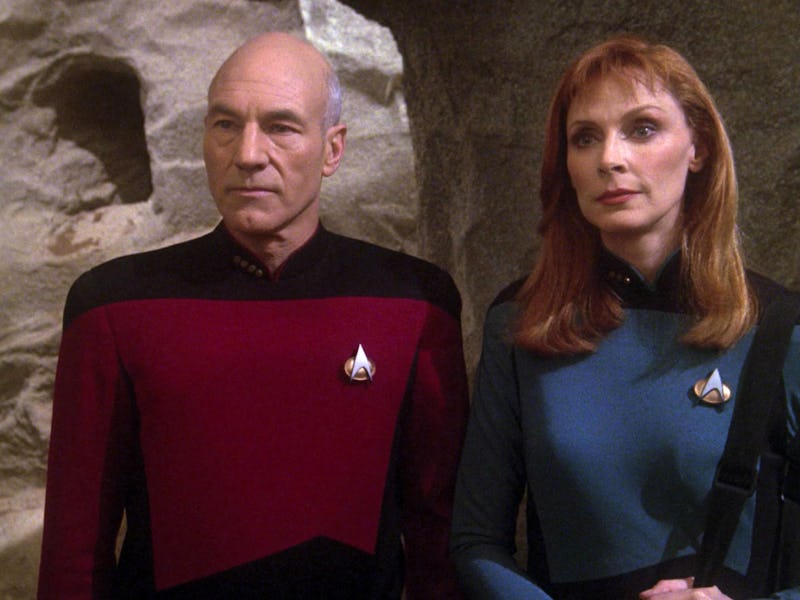
Why do so many Star Trek aliens look like humans? The real-world explanation is that way back in 1964, Gene Roddenberry said the format of Star Trek would focus on stories that took place on “parallel worlds.” This didn’t mean Trek was an alternate universe-hopping show, but that allegorically, the people encountered by the Enterprise were humanoid, thus making the stories easier to write and understand (and, from a budget perspective, easier to make). But there’s an in-universe explanation for this, too.
In 1993, Star Trek: The Next Generation devoted an episode to answering this big question. And now, 31 years later, Star Trek: Discovery is doubling down with a Season 5 storyline that serves as a direct sequel to that story. Here’s what this means and why it matters. Spoilers ahead for Star Trek: Discovery Season 5, Episodes 1 and 2.
The return of Star Trek’s Progenitors
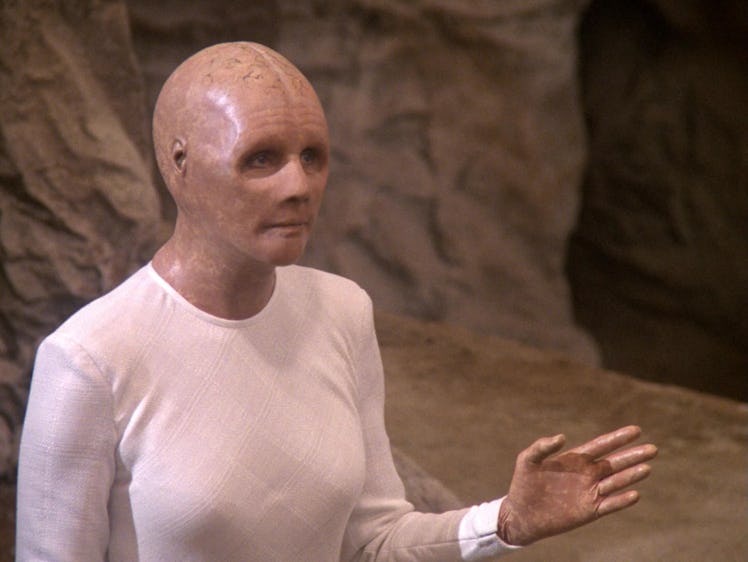
The Progenitor’s message in the Next Generation episode “The Chase.”
At the end of Discovery Season 5, Episode 1, “Red Directive,” we learn that the data the crew has been assigned to protect is connected to discoveries made by a Romulan scientist in the year 2369. Season 5 happens roughly 820 years after that date, but as Kovich (David Cronenberg) tells Captain Burnham (Sonequa Martin-Green), this information has been kept hidden for centuries. Why?
Well, in “The Chase,” Picard, Crusher, and the Enterprise-D crew — along with representatives from the Cardassians, Klingons, and Romulans — discovered an ancient message coded within DNA that revealed everyone descended from the same ancient aliens. The Progenitors, as their message explains, “...seeded the primordial oceans of many worlds, where life was in its infancy. The seed codes directed your evolution toward a physical form resembling ours.”
Captain Burnham is floored by this information, which makes sense since she’s originally from the 23rd century, and her pre-time travel adventures in Starfleet predate Picard’s by about 100 years. But Burnham’s ignorance of the Progenitors isn’t because she and the Discovery crew are time travelers. There’s another reason why this has all been classified.
Discovery’s new God-mode tech

Captain Burnham (Sonequa Martin-Green) is racing to find the most powerful Trek tech of all time.
The fact that most humanoid-looking life in Star Trek descended from an ancient alien species isn’t a new revelation to longtime Trek fans. Even Original Series episodes “Return to Tomorrow” and “The Paradise Syndrom” hinted that several species originated thanks to some kind of organized panspermia . What is new is that the technology the Progenitors used to create life on thousands of worlds has been found.
In Discovery’s “Red Directive,” the journal left by the Romulan scientist is just the first piece of the puzzle. The larger mission is to find the technology the Progenitors developed millions of years ago, and so Discovery has revealed the most powerful technology in all of Trek canon to date. In The Wrath of Khan , we got the Genesis Device , a tech capable of instantly terraforming planets. In Voyager’s “Year of Hell,” the Kremin weapon ship pushed entire planets out of the spacetime continuum, altering history in the blink of an eye.
But those examples of super-tech were unstable. What’s interesting about the ancient Progenitor tech is that it obviously works . Discovery’s imperative to find the tech is classic Trek: if the ability to seed life on a planetary scale falls into the wrong hands, the galaxy could be changed forever. In the grand tradition of Star Trek, the biggest superweapons aren’t planet-destroying superweapons, but something that could redefine and rewrite life itself.
Star Trek: Discovery Season 5 airs on Paramount+.

- Science Fiction
Den of Geek
Star Trek: Discovery Is Now Connected to a Franchise-Defining Next Generation Episode
Star Trek: Discovery beings season five with a treasure hunt, one that recalls The Next Generation episode "The Chase" and the Progenitors.

- Share on Facebook (opens in a new tab)
- Share on Twitter (opens in a new tab)
- Share on Linkedin (opens in a new tab)
- Share on email (opens in a new tab)
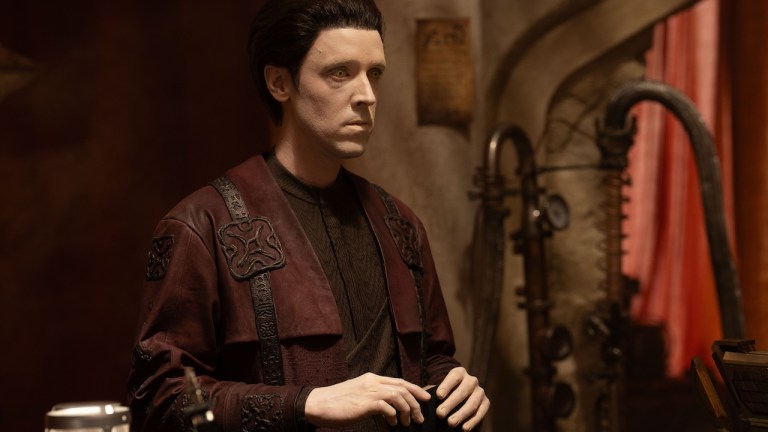
This Star Trek: Discovery article contains spoilers.
At the end of the Star Trek: Discovery season five premiere “ Red Directive ,” Dr. Kovich finally levels with Captain Burnham . The mission that she and her crew had been on throughout the episode has escalated beyond even Admiral Vance’s clearance, to a level that only someone as deep within the Federation as Kovich can understand.
The mission involves the Progenitors , the source of all humanoid life in the universe. “A few thousand years ago, we’d have found them gods,” says Kovich. But to long-time Trekkies, the Progenitors are also the topic of a remarkable episode of Star Trek: The Next Generation .
As much as we all love Star Trek and its wild world of alien races, the fact remains that the large majority of those aliens are just regular-looking humans with different bits of putty slapped on their foreheads. Romulans, Klingons, and Bajorans — the difference between them is minor. Even the more ornate aliens, such as the Cardassians or Saurians like Lieutenant JG Linus of the USS Discovery are humanoid. More out there races, such as the Medusans, are few and far between.
Ad – content continues below
Back in the 1960s, the reason for these similarities was simple. The Original Series had very limited budgets, which meant that Gene Roddenberry couldn’t get so crazy with alien designs. And while bigger budgets for the movies and The Next Generation allowed for the Klingons to develop into more complex designs, they still remain very similar to humans.
While the fact that most aliens in Star Trek are humanoids never really bothered most fans, a season six episode of TNG provided an explanation for why so many races are so similar in this universe. Written by Joe Menosky and Ronald D. Moore and directed by Jonathan Frakes, “The Chase” sent the Enterprise on an archeological quest that Captain Picard couldn’t resist.
Following the work of his mentor Professor Galen, Picard discovers material from a founding species called the Progenitors, whose genetic code has been transmitted into various successor races, accounting for their similarities. As the Enterprise searches for the missing DNA fragment in that code, it finds other vessels on the same trail. Working together, the humans, Klingons, Cardassians, and Romulans find a holographic projection of one of the Progenitors. This figure explains the shared history of the gathered delegates, and expresses their people’s desire that the connection would create peace in the universe.
Of course, that peace between the gathered races doesn’t occur until the Dominion War in Deep Space Nine , which saw the various groups band together to fight invaders from the Gamma Quadrant. But given the fractured state of the universe in the 32nd century of Discovery , the time might be right for another attempt at cooperation.
Kovach’s speech to Burnham includes images from “The Chase,” including a close-up of one of the Romulan scientists who participated in the search. Dr. Vellek, “one of the greatest scientists of his day,” according to Kovich. It was Vellek’s journal that the Discovery has been looking for, after being stolen from an ancient Romulan vessel by thieves Moll and L’ak. Why is it so important? The journal contains the location of the machinery that the Progenitors used to create life.
We don’t know much about this weapon yet, but Trekkies cannot help but recall the Genesis device from Star Trek II: The Wrath of Khan . Genesis could create life but also be used as a weapon. The second episode of Discovery ‘s fifth season “Under the Twin Moons” finds the crew wrestling with that realization regarding the Progenitor, as they search the planet Lyrek for Moll and L’ak.
Discovery executive producers Alex Kurtzman and Michelle Paradise have been quite open about the focus of this fifth season, telling Den of Geek that Burnham and crew will be on a “quest.” But by tying the object of the quest to “The Chase,” the goal becomes more than a mere MacGuffin. Rather, the Progenitor device serves as a referendum on Discovery in its final season.
Get the best of Den of Geek delivered right to your inbox!
The device can be a tool of destruction, recalling the darker and more violent first seasons of the series. Or it can be a means for peace, culminating with the spirit of cooperation and community that Star Trek has always imagined.
“Well, Captain,” Kovich tells Burnham. “The greatest treasure in the known galaxy is out there. What are you waiting for?” By bringing back the stakes of “The Chase,” Discovery pays off the promise of the episode, freeing it from an unnecessary canonical explanation (not unlike the Enterprise episode “Divergence”), and allows it to be a statement of purpose. And frankly, we cannot wait to see how Discovery pulls it off.
Star Trek: Discovery is streaming now on Paramount+.

Joe George | @jageorgeii
Joe George’s writing has appeared at Slate, Polygon, Tor.com, and elsewhere!
Why ‘Star Trek: Discovery’ Built Season 5 Around a Classic Episode From a Legacy Series
By Adam B. Vary
Adam B. Vary
Senior Entertainment Writer
- ‘The Phantom Menace’ at 25: A Lover, Hater and Newcomer Debate Jar Jar Binks, Podraces, Droids and Darth Maul 1 day ago
- ‘Red, White & Royal Blue’ Sequel in the Works, With Nicholas Galitzine and Taylor Zakhar Perez Returning 3 days ago
- Marvel’s ‘The Fantastic Four’ Adds ‘The Witch’ Star Ralph Ineson as Galactus 3 days ago

SPOILER ALERT: This story discusses major plot developments in Season 5, Episode 1 of “ Star Trek : Discovery,” now streaming on Paramount+.
Popular on Variety
Kovich’s explanation evokes the classic “ Star Trek: The Next Generation ” episode “The Chase” from 1993 in which Capt. Jean-Luc Picard (Patrick Stewart) — along with teams of Romulans, Klingons and Cardassians — learn that all humanoid life in the galaxy was created by a single species that existed billions of years earlier, and seeded thousands of planets with the DNA to pass along their legacy. (Along with presenting a profound vision of the origins of life, the episode also provided an imaginative explanation for why almost all the aliens in “Star Trek” basically look like humans with different kinds of forehead ridges.)
Kovich tells Burnham that the Romulan scientist was part of a team sent to discover exactly how these aliens — whom they call the Progenitors — made this happen; the object they’re seeking winds up being one part of a brand new “chase,” this time in the 32nd century, to find the Progenitors’ technology before it can fall into the wrong hands.
“I remember watching that episode and at the end of it just being blown away that there was this huge idea where we all come from,” Paradise says. “And then they’re going to have another mission the next week. I found myself wondering, ‘Well, then what? What happened? What do we do with this information? What does it mean?’”
Originally, Paradise says the “Discovery” writers’ room discussed evoking the Progenitors in Season 4, when the Discovery meets an alien species, the 10-C, who live outside of the galaxy and are as radically different from humans as one could imagine. “As we dug deeper into the season itself, we realized that it was too much to try and get in,” Paradise says.
Instead, they made the Progenitors the engine for Season 5. “Burnham and some of our other characters are on this quest for personal meaning,” Paradise says. Searching for the origins of life itself, she adds, “feels like a big thematic idea that fits right in with what we’re exploring over the course of the season, and what our characters are going through.”
That meant that Paradise finally got to help come up with the answers to the questions about “The Chase” that had preoccupied her when she was younger. “We had a lot of fun talking about what might’ve happened when [Picard] called back to headquarters and had to say, ‘Here’s what happened today,’” she says. “We just built the story out from there.”
More From Our Brands
To b or not to b why roger corman was one of the most influential figures in movie history, a manhattan mansion by architect robert d. kohn hits the market for $13 million, messi injury scare leads to criticism of mls’ new sit-out rule, the best loofahs and body scrubbers, according to dermatologists, yes, transplant’s final season will air on nbc — the question is, when, verify it's you, please log in.
- The Inventory

Discovery Is Opening Star Trek 's Biggest Pandora's Box
The fifth and final season of star trek: discovery has put a reveal that even the next generation dared not touch at its heart, in some fascinating ways..
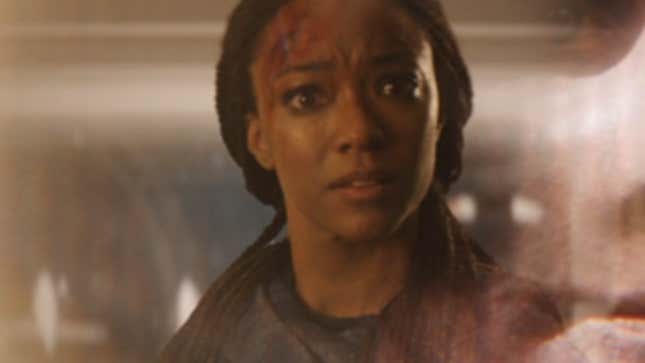
This week, Star Trek: Discovery kicked off its final season with a bold adventure—one with intimate ties to a classic Star Trek: The Next Generation story no other show in the franchise has dared to follow up on. In doing so, it’s opening up the kinds of opportunities that only Discovery really can—but it requires a delicate balancing act in the process.
Related Content

It’s fitting that Discovery ’s fifth season premiere opened on the week of what is known as First Contact Day to Star Trek fans. Just under four decades from today, during the events of, well, Star Trek: First Contact , humankind meets its first alien civilization in the Vulcans, and finds itself thrust into a much bigger galaxy than it could have ever imagined after years of devastating nuclear conflict. What better reveal then, that Discovery ’s last season will build itself around the mystery of the ultimate first contact—a chase for the alien civilization that kickstarted humanoid life across the galaxy in the first place?

This is the twist Michael Burnham discovers at the climax of Discovery season five’s first episode, “Red Directive.” The mysterious mission she’s been kept in the dark about all episode, racing after mysterious pirates and a centuries-old Romulan puzzlebox, involves a species now dubbed “The Progenitors,” an ancient precursor civilization that first became known to Starfleet and other galactic societies during the Next Generation season six episode, “The Chase”.
It’s an episode with fascinating parallels to the season-arching narrative Discovery wants to go out on, though it’s an adventure in just one hour of TV instead of a whole season. After crossing paths with his old archaeology professor, Captain Picard finds himself on a treasure hunt across the galaxy, with rival factions in the Klingons, Cardassians, and eventually the Romulans (leading to Discovery ’s way in, fictional centuries and actual decades later), after it’s discovered that the professor had discovered a secret that could either bind the whole of galactic civilization together—or shatter it to pieces, just as Burnham is warned of her own mission. While his rivals believe they’re on the hunt of an almighty weapon, ultimately what Picard and the other powers at play discover on Vilmor II is truth, and knowledge.
A holographic message from a bald, humanoid being—played beautifully such a short time by Salome Jens, who would go on to play a similar looking but altogether more horrifying Star Trek alien in her role as the Female Changeling heading the Dominion’s invasion of the Alpha Quadrant in Deep Space Nine —reveals that her species, long dead, evolved too soon to meet similar sentient life in the galaxy. So, in the hopes of spreading their legacy across the stars, they seeded life in their image—bipedal, humanoid, smooth-skinned, and (for the most part) hairless—across the galaxy, and left clues so that one day when that life evolved and took to the stars as they had, they could discover their shared origin, and do so together .
“The Chase” concludes on an optimistic, but non-committal note, in spite of the gravity of its reveal that intelligence design doesn’t just exist in Star Trek , but is both a fun metatextual answer to why most aliens in the franchise conveniently look like humans in various color palettes and with extraneous latex bits, and also a piece of worldbuilding that fundamentally reshapes its whole universe. While the Klingons and Cardassians, who’d assumed they were hunting for power and technology, are disgusted by the thought of common ancestry, Captain Picard and his Romulan counterpart express that the revelation could one day bring peace—not just between their own civilizations, but across the entire galaxy.
Star Trek promptly never went there again, boldly or otherwise.
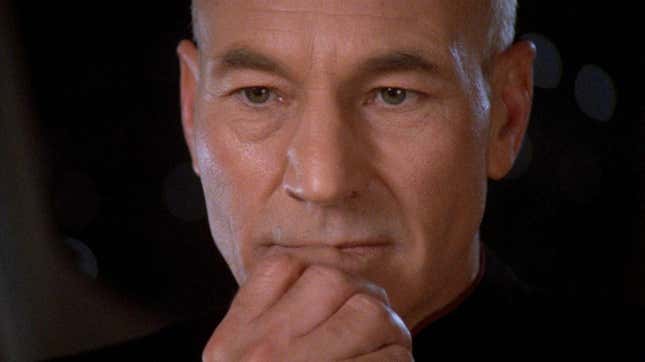
There have been Star Trek stories since that examine the evolution of life across its universe—like Voyager ’s fascinating “Distant Origin,” where a scientist from a Delta quadrant species called the Voth discovers they are descended from Earth’s dinosaurs—but it took three decades for the franchise to pick up directly where “The Chase” left things off as Discovery did this week. It’s already expanded upon the episode, giving the alien species an alternative name in the “Progenitors,” as well as the revelation from Michael’s quest that they did not just leave behind their knowledge, but elements of the actual technology they used to shape life after the decline of their civilization... technology that yes, now, as the Klingons and Cardassians dreamed of in “The Chase,” could be weaponized in certain hands.
It’s already interesting that Discovery would take what was, well, a discovery of knowledge, and turn it into a more tangible, galaxy-threatening object. But it’s also interesting in what Star Trek says about itself only just picking up on the potential of “The Chase” now , not just in terms of the actual, literal decades its been since that TNG episode, but in picking it up in Star Trek: Discovery , a series now set in the furthest point of time any series of the show has regularly taken place in, the 32nd century. We already know that the Progenitors’ dream of unity among its myriad descendants has not happened—just four years after “The Chase,” the Alpha Quadrant is torn apart with Salome Jens’ return as the Female Changeling, and with her the start of the Dominion War . We know further still that, by the time Burnham and her crew have jettisoned themselves into the 32nd century, the galaxy is no more united that in was in their original time—if anything, it’s more divided than it had been in centuries, the Federation and Starfleet shattered into disparate pieces by the impact of “The Burn” and the diminishment of warp travel explored in Discovery season three.

Star Trek is forever in the process of progress toward the utopia it’s always maintained it has attained in the first place— always challenging its ideals to strengthen them, and challenging them through conflict and division. But it says a lot that 30 years ago the franchise laid out the ultimate pathway to peace, and that utopic aim across the stars, and then simply... did not touch it again until now.
And yet, perhaps it’s perfect that it is Star Trek: Discovery that’s decided to pick up the pieces. Time will tell just what happens in Michael and her crew’s adventure across the galaxy to find all the puzzle pieces they need, and just what shape this Progenitor technology will eventually take. But Star Trek: Discovery has, across its lifetime, always championed the power of connection—on individual and galactic scales—in the face of adversity, and come out on top time and time again. In season four , Captain Burnham already achieved the seeming impossibility of peaceful first contact with an extragalactic race unlike anything the shared-ancestry siblings of Star Trek ’s galaxy had ever really known before. After that, exploring the untouched legacy of one of The Next Generation ’s most fascinating episodes—and perhaps finding a way to make that power of connection really tangible across its universe—is definitely something that could be on the cards. For a show that has pushed Star Trek ’s continuity further and further forward across its life, doing so would be a fitting achievement to go out on.
Want more io9 news? Check out when to expect the latest Marvel , Star Wars , and Star Trek releases, what’s next for the DC Universe on film and TV , and everything you need to know about the future of Doctor Who .
Memory Beta, non-canon Star Trek Wiki
A friendly reminder regarding spoilers ! At present the expanded Trek universe is in a period of major upheaval with the continuations of Discovery and Prodigy , the advent of new eras in gaming with the Star Trek Adventures RPG , Star Trek: Infinite and Star Trek Online , as well as other post-57th Anniversary publications such as the ongoing IDW Star Trek comic and spin-off Star Trek: Defiant . Therefore, please be courteous to other users who may not be aware of current developments by using the {{ spoiler }}, {{ spoilers }} OR {{ majorspoiler }} tags when adding new information from sources less than six months old (even if it is minor info). Also, please do not include details in the summary bar when editing pages and do not anticipate making additions relating to sources not yet in release. THANK YOU
- Mythological characters
- Changeling culture
- View history
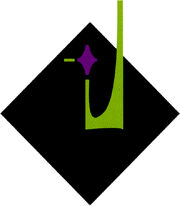
The Progenitor was a possibly mythical shapeshifting being that, according to the Founders , created the universe and everything in it. The Founders believe that the Progenitor took a population of 'solids' and imbued in them its own malleable characteristics, thus creating the Great Link .
The Progenitor later disappeared, leaving the Founders unable to procreate, though with very long natural lives. After being unsuccessful in their attempts to find it, the Founders withdrew to the Omarion Nebula , from where they sent out the Hundred to lure the Progenitor to a system close to, but outside, the Omarion Nebula.
In 2376 , it was believed the Progenitor had returned and Odo , Laas and Indurane investigated. They later found what they believed to be the Progenitor, although it had been killed by the radiation of a isolytic subspace weapon detonated by the Ascendants . The death of the Progenitor left the Founders crushed by guilt at what they had done to the Hundred, and thus, to the Progenitor. With their only hope for saving themselves from extinction now gone, the Great Link dispersed, with most Founders choosing to live in isolation, even from each other, though some Changelings chose to remain in small links together.
Taran'atar was told of the Progenitor's existence by the Female Changeling . This made him doubt the divinity of the Founders. ( DS9 novels : The Dominion: Olympus Descending , Warpath )
- 1 Ferengi Rules of Acquisition
- 2 Odyssey class
- 3 Akira class
Why Star Trek: Discovery Chose That Classic Next Gen Storyline To Explore In Its Final Season
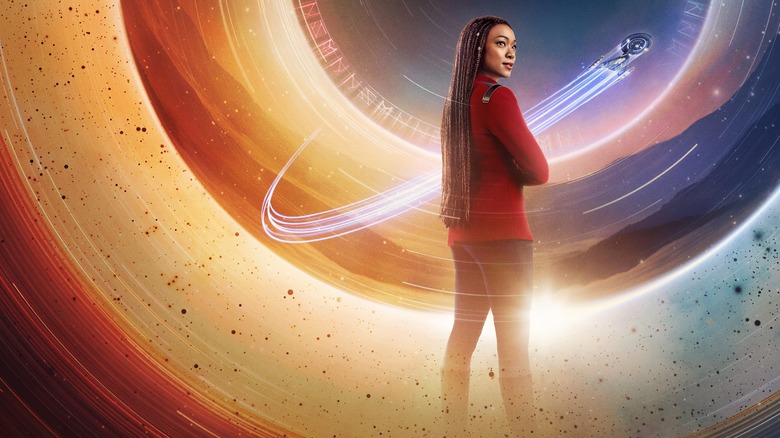
Shields up! This article contains major spoilers for the season 5 premiere of "Star Trek: Discovery."
Who knew that "Star Trek: Discovery" would be saving its biggest reveal for last? After being responsible for kickstarting the new era of "Trek" on streaming , the fifth and final season is signaling the beginning of the end for the flagship series. But as fans would expect, the opening episode proves the writing team has no intentions of taking its final bow without crafting one last adventure worthy of Captain Michael Burnham (Sonequa Martin-Green), Mr. Saru (Doug Jones), and the rest of the Discovery crew. (For more on that, you can check out /Film's "Discovery" season 5 premiere review by Jacob Hall here .) So perhaps it was inevitable that the biggest twist of the young season would have its roots in one of the most game-changing hours of "Trek" lore ever.
Trekkies will no doubt remember the classic "Next Generation" episode "The Chase," which first introduced the extinct race known as the Progenitors. Responsible for seeding humanoid life throughout the galaxy, these ancient beings were meant as an in-universe explanation for why almost every alien race encountered by Starfleet looked mostly like, well, ourselves ... give or take a few random ridges on foreheads and such. This also had the side effect of linking even the biggest enemies — humans, Romulans, Cardassians, and even Klingons alike — on a foundational genetic level.
"The Next Generation" mostly breezes past this revelation and reverts to business as usual in later episodes, despite the startling implications, so leave it to "Discovery" to pick up this major dangling thread and weave it into the fabric of this new season. At the season 5 world premiere, producer Michelle Paradise addressed why the show's creatives went back to this storyline in particular.
'Huge ideas and huge themes'
How do you raise the stakes even higher than the time-traveling shenanigans of "Discovery" season 2, the mysterious dilithium "Burn" of season 3 that caused the breakdown of Starfleet, and the impossibly advanced species of extraterrestrials that put the entire galaxy at risk in season 4? Well, going all the way back to the origin of life as we know it is definitely one way to get the job done and end things with a bang.
It took until the closing moments of the season 5 premiere for the full picture (or part of it, at least) to round into shape, but what a twist it is! As it turns out, the pair of scavengers who absconded with an item of top priority to Starfleet couldn't have possibly picked a more important piece of "Trek" lore: the leftover Progenitor tech that helped them create humanoid life in the first place. So why tie things back to that underrated "The Next Generation" episode , of all things? At the SXSW premiere of "Discovery," producer Michelle Paradise had this to say:
"'The Chase' is an episode that had stuck with many of us because it addresses such huge ideas and huge themes. Where do we come from, the creation of life. And then it was this one episode, and then that was it [...] And it just left us with many, many questions."
That's putting it mildly. Even for a sci-fi franchise like "Star Trek," those are some incredibly heady ideas to attempt to tackle. It's one thing for a random episode in the early 1990s to suddenly establish such a massive change to canon. It's quite another for "Discovery" to double down. According to Paradise, however, this was done with character and theme in mind.
Tackling the big questions
Arguably more than any other ongoing series, "Discovery" has always worn its heart on its sleeve. That doesn't appear to be changing in season 5, but it's only fitting that the final adventure for this cast digs deeper into the psyches of the characters than it ever has before. The biggest question on the minds of the creative team, as it turns out, revolved around ideas of meaning and purpose for Burnham, Saru, and all the rest. According to Michelle Paradise, those are existential topics that translate naturally from the events of "The Chase," set hundreds and hundreds of years before the future timeline of this current season of "Discovery." She went on to say:
"And so when we were thinking about this season in particular and what we were going to be doing thematically and our characters looking at questions of meaning, questions of purpose. It felt like that was a really great place to go back to as a launching point for this adventure and that it was going to have that resonance."
For a crew that's been stranded in the future and cut off from everyone they used to know, these are poignant issues that previous seasons of "Discovery" have sought to explore. After having rebuilt Starfleet to something close to its former glory and putting the officers of the Discovery through the wringer, the rest of season 5 is now primed and ready to push these characters where they have never gone before.
New episodes of "Star Trek: Discovery" season 5 premiere on Paramount+ every Thursday.
‘Star Trek: Discovery’s Connection to ‘The Next Generation’ Explained
...And it involves a new crew.
The Big Picture
- The USS Discovery embarks on a red directive mission with ties to Star Trek lore, focusing on the Progenitors' technology.
- New faces join the crew on a mission to uncover an artifact related to the Progenitors in the Next Generation era.
- The technology to create life poses a powerful threat if misused, as Moll and L'ak aim to sell the artifact to the highest bidder.
The first two episodes of Star Trek: Discovery Season 5 are finally available on Paramount+, putting Captain Michael Burnham ( Sonequa Martin-Green ) and the crew of the U.S.S. Discovery back on the boldly going business. This time, they're not going another 800 years into the future, but instead, their mission has a connection to another time: the Star Trek: The Next Generation era. Back then, Captain Jean-Luc Picard ( Patrick Stewart ) once led the U.S.S. Enterprise-D on a mission that uncovered the secrets of life itself as we know it . It may have been a one-episode story, but it's now getting the proper arc it deserves; the time has finally come to learn the secrets of the Progenitors.
Star Trek: Discovery
Taking place almost a decade before Captain Kirk's Enterprise, the USS Discovery charts a course to uncover new worlds and life forms.
The Discovery Is Given a Red Directive Mission by Dr. Kovich
The final season of Discovery starts off with its foot on the door, with ties to past Star Trek lore and the return of Dr. Kovich ( David Cronenberg ), which always means business for the Discovery crew. This time, his mission is so important that it interrupts a Starfleet event, but can't be disclosed because it's a red directive (a mission of a highly classified and dangerous nature that takes precedence over all other tasks) . Captain Burnham doesn't like the idea of keeping secrets from her crew, but since the Discovery is the only ship that can take this mission thanks to its spore drive, she accepts it.
The secretive mission introduces some new faces to Discovery , including couriers, Moll ( Eve Harlow ) and L'ak ( Elias Toufexis ), as well as U.S.S. Antares Captain Rayner ( Callum Keith Rennie ). The mission was to retrieve an artifact from a Romulan science ship that had been adrift for 800 years, but Moll and L'ak beat them to it, then take the artifact to the planet, Q'mau, where the synthetic antique dealer, Fred ( J. Adam Brown ), opens it up and reveals a diary written by the Romulan scientist, Vellek ( Michael Copeman ). Even though Moll and L'ak have escaped Starfleet in Q'mau, Admiral Charles Vance ( Oded Fehr ) helps officer Sylvia Tilly ( Mary Wiseman ) obtain information on Vellek.
As it turns out, Vellek was once part of a group that—under the leadership of Captain Jean-Luc Picard —attempted to solve the mystery of the planet Vilmor II. There, they found out about a race of humanoid aliens known only as the Progenitors , who have created life in its humanoid form and are the common link between all present humanoid species in the galaxy. The Discovery's mission, however, isn't about the Progenitors themselves, but rather about the technology they used to do what they did.
The Progenitors’ Story Comes From a Single Episode in ‘Star Trek: The Next Generation’
Season 6, Episode 20 of The Next Generation , "The Chase," is one of the wildest in the entire series. For the first time ever, a Star Trek episode shows Humans, Klingons, Romulans, and more together in the same scene. That's all thanks to one of the most interesting plots in the franchise, which sees these races coming together to discover the secret of their common origin. Unfortunately, The Next Generation didn't carry on with this plotline, but Discovery is finally giving it the sequence it deserves.
"The Chase" starts off with Captain Picard meeting his old mentor, Professor Galen ( Norman Lloyd ), aboard the Enterprise-D. The scholar is there to recruit Picard for a long-term mission that will result in the most important scientific discovery of their time, but Picard can't give up his post on Starfleet. Picard decides to take the Enterprise-D and finish what Galen started. He begins by analyzing the data his mentor had gathered (large blocks of numbers laid out in a sort of sequence). Following this trail, he eventually discovers that the numbers are actually a DNA sequence. On the planet, Loren III, Picard intervenes and mediates their conflict upon learning that both of them are there for the same reason the Enterpreise-D is, calling for them to analyze the combined DNA strands they have. They learn that those are all part of a puzzle, with each sequence complementing one another, but that there are still missing pieces.
The Enterprise-D follows the Cardassians to Vilmor II with the Klingon emissary on board, and they find out the planet has lichen growing on the dried-up ocean floor. Discreetly, Dr. Beverly Crusher ( Gates McFadden ) inserts all the DNA samples they now have onto her tricorder, which then projects the recording of a humanoid woman ( Salome Jens ). Thankfully, everyone stops arguing to listen to the projection, as the woman explains that she belonged to a race of ancient aliens from 4.5 billion years earlier. Her species eventually came to terms with their extinction, but they sowed pieces of their own DNA on many planets where life could grow across the galaxy as a way of ensuring a lasting legacy . Their intention was for all those future species to come together upon discovering their shared ancestry . Cardassians and Klingons immediately resume their bickering, unable to accept that they have anything in common. Later, Picard ponders with the Romulans that one day, in the future, perhaps all species will learn to coexist for the sake of their shared ancestry.
Where Does This Leave Captain Burnham and the Discovery Crew?
The race of ancient humanoids is never named onscreen, but they are referred to as the Progenitors from then on. With Discovery finally finishing this loose thread in Star Trek lore, it's important to ponder that the Progenitors must have used powerful tech to sow their DNA across the galaxy, which is what the overall plot of the season is going to be. The technology to create life is powerful by definition , and can be used for terrible things if it falls in the wrong hands. Right now, Moll and L'ak have the diary, but they're unwilling to cooperate with the Federation after a failed negotiation attempt by Cleveland "Book" Booker ( David Ajala ). However, they're looking to sell the diary to the highest bidder.
After the events of the first part of the season premiere , "Red Directive," Captain Rayner has been discharged from his command of the U.S.S. Antares. As sad as it is to see an officer of 30-plus years being discharged, it's also very serendipitous, as Captain Burnham is in need of a new number one for the Discovery as Saru ( Doug Jones ) is about to take a new diplomatic post for the Federation. During their chase on Q'mau, Rayner mentions that he has history chasing Moll and L'ak, which will surely come in handy . Also, Book finds out he has a past connection to Moll that makes them all but family, which is another potential lead to finding her.
Star Trek: Discovery is available to watch on Paramount+ in the U.S.
Watch on Paramount+
‘Star Trek: Discovery’ Star Talks [Spoiler]’s Death: ‘I Kind of Sussed It Out’
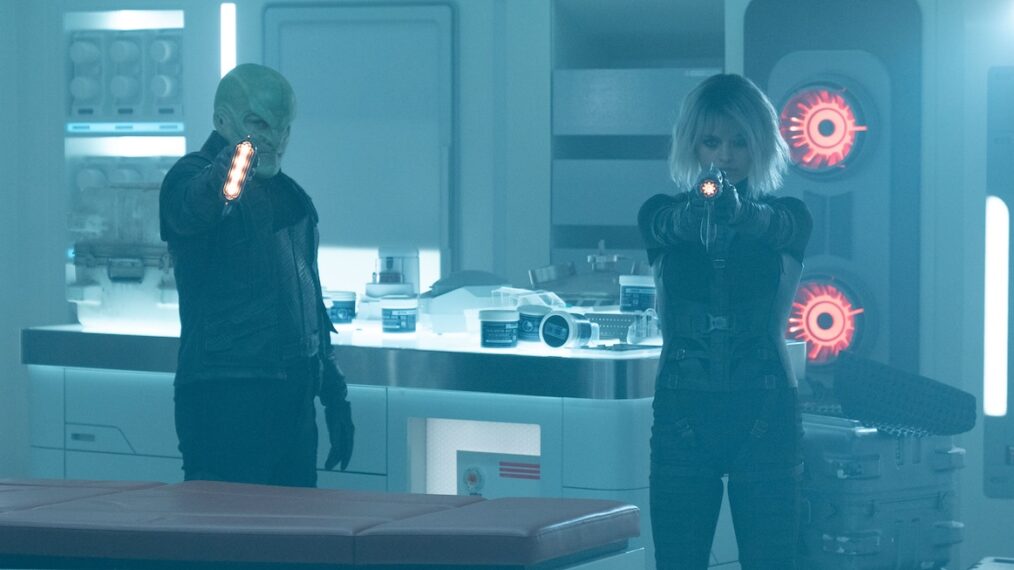
Spoiler Alert
‘star trek: discovery’: cadet badge.
[Warning: The below contains MAJOR spoilers for Star Trek: Discovery Season 5 Episode 7 “Erigah.”]
“We’re going for empathy, and if you empathize with him and Moll, and if you were sad when this episode finishes, then we did our job,” Elias Toufexis says of his and Eve Harlow ‘s Star Trek: Discovery characters in Thursday’s new episode.
In it, L’ak and Moll end up back on Discovery as prisoners, with the former receiving as much medical care as Culber ( Wilson Cruz ) can offer, given his knowledge of the Breen. Speaking of the Breen, multiple primarchs are after L’ak in hopes of using him to secure status. L’ak and Moll, of course, just want off the ship, so he comes up with a plan: He creates a distraction by injecting himself with what ends up being a fatal dose while she gets away to the shuttle; she was supposed to beam him aboard after, but in the end, she returns to him to say goodbye. Then , Moll offers herself—and her knowledge of the Progenitors’ power the Federation is after—up to the Breen.
Below, Toufexis tells us when we found out about L’ak’s death, filming his final scene, and what, as a Star Trek fan , he took from set.
When we spoke about 505, you talked about not knowing about L’ak and Moll’s backstory until you got the script. So talk about finding out that L’ak was going to die.
Elias Toufexis: I kind of sussed it out on my own in a weird way before I got the script because I realized where they were going with it and that they wanted to have a reason for the Breen and the Federation to kind of go at each other more than just normal, everyday Star Trek political stuff. And I thought, well, the reason is going to be that L’ak’s going to die or L’ak’s going to be prisoner for them or something’s going to happen to L’ak that makes them fight each other or not like each other more. So I kind of sussed out. I’m like, I bet you he’s going to die.
I don’t remember when they told me, honestly. I think it was a couple episodes before. Obviously, I didn’t get it the day of or anything, and it just made sense to me story-wise that I knew it was coming, and I was sad. I mean, there’s two parts of it. There’s the fan and the actor loving working with all the people — because Discovery ’s one of the best sets I’ve ever been on — working with all those people. That was sad. But then there was a part of me going, I’m kind of glad I don’t have to get up and put that makeup on tomorrow. I was sad to see him go, and you kind of want them to have a happy ending, especially after you see their past. So yeah, it was a sad but happy day when we finally wrapped that episode.
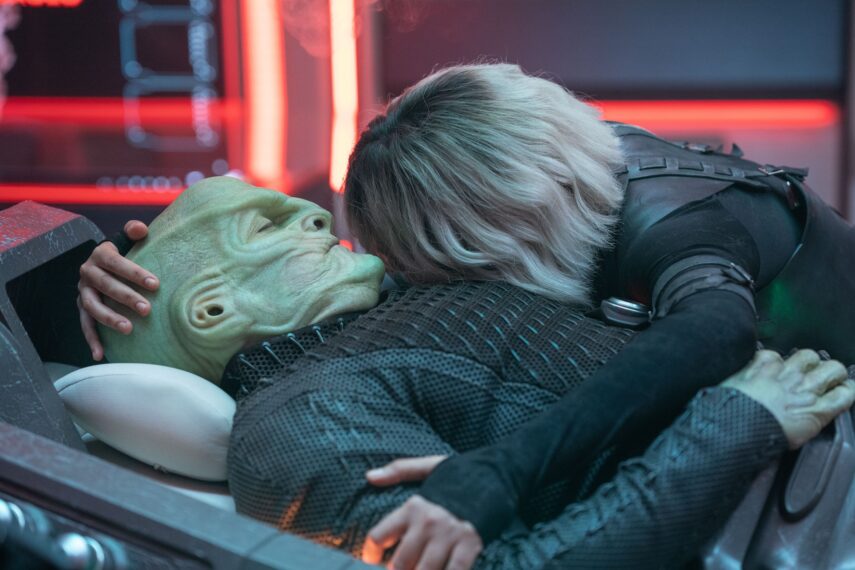
Marni Grossman / Paramount+
Did part of L’ak know that he wasn’t going to make it out alive and just tell Moll that she could get him after she left? Or did he truly think that he could get away with this plan?
I think he did some math in his head, and it was like 80-20 he’s not going to survive this. But more than anything, he just wants Moll to be okay. But there was that 20 percent—I played it at least that there was a chance he’s going to be… he’s in a med bay, so I think he was like, “I’m in sick bay. They could probably fix me if it’s really bad, but by that time, Moll will get away. It is probably really bad when he is dying there and then Moll shows up and he’s like, “You’re still here?” That’s probably what I should have played instead of dying. I should’ve been like, “Why are you here?” [ Laughs ] But I think he knew it was a sacrifice. I don’t know that he knew it was a fatal sacrifice, but he knew it was a big risk, but he did it for her.
Talk about filming L’ak’s death scene and that farewell to Moll.
Yeah, it was mostly Eve that makes that work. I had the easier job. I just had to lie there and look at Eve being sad and just be like, okay, I can just work off of that. If I’m honest, it is tough getting the empathy through the makeup and through the contact lenses. It is very tricky. And I had to force myself to overplay things. I normally consider myself a pretty naturalistic actor that doesn’t do much, and I let the camera do a lot of work. Maybe that’s just lazy.
But with Episode 5, I really wanted to get through the makeup and make the love come through and the relationship come through. And when I watched it, I’m like, okay, it does really work. And then I was genuinely worried, is the death scene going to come through? Because you do have to see that emotion through those damn contacts, and it works. I think it works mostly because of Eve’s performance. I was just pretty much playing it straight and Eve brought all the emotion in that scene. It was tough, but I don’t know, in the end, it wasn’t like we were all sitting there depressed or anything. We did the scene and we knew it was coming and we did it at the best we could, took a minute or two to recover after every take, and then were fine.
How would L’ak feel about Moll’s move to offer herself and the power the Federation is after up to the Breen?
I love that she does that because my favorite thing about that is that we’re playing this whole thing about making them sympathetic. They’re actually maybe good guys and they’ll team up with the federation. The first thing she does is throw the Federation under the bus. She’s like, oh, screw these guys. Yeah, no, they were married. I think L’ak knew what he was doing when he was marrying her.
“In case I go, you have this connection now to the Breen, to us. I don’t care if you’re not accepted, this is a statement.” So by marrying her, I think he knew that that could be a possibility. It almost guarantees her safety in a way. So I don’t know that he’d be like, well, yeah, take my body and go hang out with the Breen. But he trusts her implicitly about doing the right thing for them. So if this is her decision, he would know that she’s doing the right thing to protect herself.

Wilson Cruz Recalls 'Star Trek: Discovery' Audition & Being 'Formidable Enough'
Would he want her to bring him back if she could? Because that’s always the question in these things: If you could bring someone back, should you?
It’s a good question. I don’t know that I thought about it that much. I think it just folds into he knows that she will do what’s best for them, and if that’s trying to bring him back from the dead or something, or if it’s just using him and his place in the Breen kind of hierarchy to get her freedom, do that. Whatever you think is best for you, that’s why I did this sacrifice.
Would he have made the same decisions if their positions had been reversed? It’s very different for him to go back to the Breen than it is for her to go to them.
Yeah, I don’t know that he would have. Much like in Episode 5 when Michael [ Sonequa Martin-Green ] is offering him an out kind of, you’ll go to jail, and he starts considering it and he starts saying, “Well, will we do our time together?” You kind of realize that Moll probably wouldn’t do that. So they both want the same thing. Maybe they think there are different ways to get it, but I think, like I said, he trusts her and he puts all of his trust in her. That’s why he marries her.
Since you are a Trek fan, were you able to take anything from the set?
Nothing I’m going to tell you about. Yes, I have some stuff. I definitely have some stuff—not from the set. I didn’t steal from the set. I was sent, because I asked, some wardrobe stuff, but I didn’t steal. Oh my God, I wanted to take a tricorder. I wanted to, but I wasn’t going to steal from the Strange New Worlds set. They might need it, but I definitely asked for some L’ak wardrobe pieces and they sent [them to] me. I also asked for a shirt that Book wears because I love it, just as a fashion shirt, and they sent it to me. Yeah, so I’ll show up when I see [David] Ajala next at some Comic-Con. I’ll wear his Book shirt. I’ll be like, this is yours, man.
Star Trek: Discovery , Thursdays, Paramount+
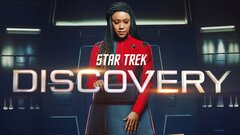
Star Trek: Discovery where to stream
Star Trek: Discovery
Elias toufexis.


Star Trek: Discoverys Elias Toufexis Reveals How Long Moll & L'ak Ran From The Breen
Warning: This Article Contains SPOILERS for Star Trek: Discovery Season 5, Episode 7 - "Erigah"
- Elias Toufexis wants to explore the untold 2-year backstory of Moll and L'ak in Star Trek: Discovery season 5.
- There's potential for Moll and L'ak's journey across the galaxy as couriers on the run from the Breen.
- The flashbacks in episode 5 of season 5 took place in 3189 during Star Trek: Discovery season 3.
Elias Toufexis wants the untold story of Moll and L'ak that Star Trek: Discovery season 5 only hinted at and reveals how long the renegade lovers ran from the Breen. Toufexis plays L'ak, who is a Breen in love with a human courier named Moll (Eve Harlow). L'ak escaped the Breen to be with Moll, which earned the couple an Erigah, or Breen blood bounty, from L'ak's cruel uncle, Primarch Ruhn (Tony Nappo). Sadly, Moll and L'ak''s dreams of freedom together came to a tragic end in Star Trek: Discovery season 5, episode 7, "Erigah",
In an upcoming exclusive interview with Screen Rant to discuss L'ak's fate in Star Trek: Discovery season 5, episode 7 , Elias Toufexis responded to a suggestion that there's an alternate Star Trek timeline where Moll and L'ak escaped aboard the Mirror Universe's ISS Enterprise and got to write their own destiny. Toufexis said:
You know what story I want to write? There's two years between when Moll and Lak escape the Breen to when Red Directive starts. Where's that story?
It was unclear how long Moll and L'ak were on the run from the Breen, so Elias Toufexis confirmed the flashbacks in Star Trek: Discovery season 5, episode 5, "Mirrors", took place in 3189 during Star Trek: Discovery season 3.
Star Trek: Discovery Season 5 Returning Cast & New Character Guide
As Burnham seeks the universe's greatest treasure in Star Trek: Discovery season 5, she'll need help from a host of new and returning characters.
L'ak's Death In Star Trek: Discovery Season 5 Explained
Moll needs the progenitors' treasure to resurrect l'ak.
L'ak shockingly died in Star Trek: Discovery season 5, episode 7, "Erigah." L'ak was seriously injured in a fight with Captain Michael Burnham (Sonequa Martin-Green) aboard the ISS Enterprise in Star Trek: Discovery season 5, episode 5, "Mirrors." Moll and L'ak were captured by Starfleet and being held in the USS Discovery's sickbay so L'ak could receive medical attention. But the couple feared being turned over to the Breen so L'ak created a medical distraction so that Moll could escape. But L'ak accidentally overdosed on tricordrizine, and he passed away with Moll at his side.
Moll's desperate hope is to resurrect L'ak with the Progentors' life-giving science.
Moll and L'ak originally sought the Progenitors' treasure as a bargaining chip for the Breen to lift the Erigah on their heads. But rather than remain in Federation custody, Moll told the Breen about the Progenitors' technology and pledged to help L'ak's people find it. Moll's desperate hope is to resurrect L'ak with the Progenitors' life-giving science. Moll also revealed to Primarch Ruhn that she and L'ak were married , which gives her a form of protection as L'ak was the Scion and direct blood descendent of the late Breen Emperor. How Moll and L'ak's story will end in Star Trek: Discovery remains to be seen, but Elias Toufexis is right that they still have so much backstory yet to be told.
Source: Screen Rant Plus
New episodes of Star Trek: Discovery season 5 stream Thursdays on Paramount+
Cast Blu del Barrio, Oded Fehr, Anthony Rapp, Sonequa Martin-Green, Doug Jones, Wilson Cruz, Eve Harlow, Mary Wiseman, Callum Keith Rennie
Streaming Service(s) Paramount+
Franchise(s) Star Trek
Writers Alex Kurtzman
Directors Jonathan Frakes, Olatunde Osunsanmi
Showrunner Alex Kurtzman
Where To Watch Paramount+

Screen Rant
Star trek: discovery season 5 episode 6 ending explained.

Your changes have been saved
Email Is sent
Please verify your email address.
You’ve reached your account maximum for followed topics.
Star Trek: Discovery Season 5 Returning Cast & New Character Guide
Star trek: discovery proves starfleet academy show doesn’t make sense without tilly, wilson cruz killed it playing star trek: discovery's trill.
WARNING: Contains SPOILERS for Star Trek: Discovery, season 5, episode 6, "Whistlespeak".
- Burnham's decision to break the Prime Directive saved Tilly and the Halem'nites from certain death.
- Tilly's struggles with Starfleet Academy students hint at a future storyline for Star Trek: Starfleet Academy.
- Culber's spiritual awakening challenges Star Trek's rationalism, leading to a deeper exploration of his character.
By the end of Star Trek: Discovery season 5, episode 6, "Whistlespeak", Captain Michael Burnham (Sonequa Martin-Green) and the crew are one step closer to the Progenitors' technology, following a mission to a pre-warp society that risked the life of Lt. Sylvia Tilly (Mary Wiseman). After last week's big revelations about the Mirror Universe, Moll (Eve Harlow), L'ak (Elias Toufexis), and the Breen Imperium, "Whistlespeak", written by Kenneth Lin and Brandon Schultz, and directed by Chris Byrne, is a more traditional Star Trek adventure. Seeking the next clue on the planet Halem'no, Burnham and Tilly join the Journey of the Mother Compeer.
This religious pilgrimage takes the form of a race to prove devotion to Halem'no's gods, in the hope of making it rain again. However, this religious pilgrimage has life-threatening consequences for Tilly , providing Burnham with a dilemma over whether she breaks Star Trek 's Prime Directive to save her friend. Elsewhere, on the USS Discovery, Ensign Adira Tal (Blu del Barrio) is struggling to settle into their new role as science officer on the bridge, while Dr. Hugh Culber (Wilson Cruz) gets closer to coming to terms with his spiritual awakening, courtesy of some wise words from Cleveland Booker (David Ajala).
As Burnham seeks the universe's greatest treasure in Star Trek: Discovery season 5, she'll need help from a host of new and returning characters.
Captain Burnham Broke The Prime Directive To Save Tilly
The halem'nites and tilly would have died without burnham..
Believing that the next clue to the Progenitors' treasure was hidden in the High Summit, a weather tower disguised as a mountain, Burnham and Tilly joined the pilgrimage in the hope of making it inside. However, it quickly transpired that once inside the tower, there was no way out. Designed by Denobulan scientist Hitoroshi Kreel , the towers were designed to protect the Halem'nites from the punishing dust storms that take place on their planet. Tilly and young initiate Ravah (June Laporte) became trapped inside the vacuum chamber, meaning that they would suffocate to death unless they were rescued.
The Denobulans were introduced in Star Trek: Enterprise via the Enterprise NX-01's Denobulan Dr. Phlox (John Billingsley).
Discovery was unable to beam Tilly and Ravah out of the weather tower due to the walls being made of tritanium, making it impossible to get a transporter lock . Which is why Burnham made the difficult decision break the Prime Directive by beaming into the weather tower's control room to reveal the truth to Ohvaz (Alfredo Narciso). Burnham was right to break the Prime Directive , because the Denobulan weather towers were failing, and in drastic need of repair. Without Burnham's intervention, Tilly and Ravah would have died for no reason, and the Halem'nites would have eventually been driven to extinction .
While it's definitely a breach of the Prime Directive, Burnham is still very careful not to destroy Ohvaz's beliefs , telling him that " Nothing we have shown you means gods don't exist ". Indeed, Burnham's quest for life itself is proof of some higher power in the Star Trek universe . While Commander Rayner (Callum Keith Rennie), Tilly, and Burnham all lament the inevitable ramifications, it seems likely that Dr. Kovich (David Cronenberg) will brush off this breach of the Prime Directive in favor of Discovery's Red Directive mission .
There is a Prime Directive exception to allow repairs to existing "contamination" as long as it doesn't interfere with the natural growth of the populace, which is effectively what Burnham did on Halem'no.
Tilly's Away Mission Sets Up Star Trek: Starfleet Academy
Starfleet academy is failing its new students..
Star Trek: Discovery season 5, episode 6, "Whistlespeak" appears to set up Star Trek: Starfleet Academy by revealing more about Tilly's struggles to get through to her students . Discussing her new career with Burnham, Tilly reveals that one of her students wants to quit the Academy to take a position aboard a cargo freighter. Later, when they meet Ravah, Tilly notes the similarities between the young woman keen to prove herself to her gods and the Starfleet Academy cadet who wants to get out into the stars as soon as possible.
The cast of Star Trek: Starfleet Academy has yet to be announced, but Mary Wiseman's Lieutenant Sylvia Tilly should definitely be a part of it.
Tilly and Ravah's instant connection is a welcome reminder of why Tilly's such a good fit for Starfleet Academy . Tilly's empathy for Ravah, and the gut-wrenching guilt when she realizes that she's signed her death warrant demonstrates the huge responsibility involved in training new Starfleet officers. Confiding in Michael, Tilly reveals that she thinks Starfleet Academy is failing their students, perhaps focusing more on the theoretical than the practical. Tilly's final mission on the USS Discovery, and interactions with characters like Ravah could help her to reform the institution when she returns to Starfleet Academy.
The Meaning of Denobulan's Progenitors Clue Explained
"...we need to be so careful.".
In Star Trek: Discovery season 5, episode 5 , "Mirrors", Burnham and Book realized that each of the clues to the Progenitors' treasure contained important lessons. For example, the clue hidden on Trill, in the heart of an Itronok nest, was designed to test whether Book and Burnham valued life-forms different from their own. As with all the previous clues, the one left behind by Denobulan scientist Kreel contains a message, which is discussed by Burnham and Tilly, after they secure it from the dormant fifth weather tower.
It transpires that the cultural impact of the technology installed on Halem'no by the Denobulans was the lesson . When the towers began failing, the Halem'nites began sacrificing themselves to make it rain, something that the Denobulans could never have predicted. It's a reminder to Burnham and Tilly that when they eventually find the Progenitors' technology they have to be very careful with how they use it. The fifth and final clue, located in the fifth weather tower, is written in Betazoid text, left behind by the fifth and final scientist, Marina Derex.
Dr. Culber Is Coming To Terms With His Experience On Trill
Culber's had a "thrilling" spiritual awakening..
Dr. Culber's spiritual awakening has been one of the most interesting storylines in Star Trek: Discovery season 5, as it challenges the franchise's stance on religion . The clash between Star Trek 's rationalism and Culber's spiritualism is exemplified by his discussions with a hologram of his Abuela (Maria del Mar), a spiritual woman who raised Hugh to be a man of science. However, after spending the episode trying to find a scientific explanation, Culber instead realizes that there isn't one , and that his mind is instead opened up to new possibilities and something larger than himself.
At the end of Star Trek: Discovery season 5, episode 6, Dr. Culber discusses his new awakening with Book, who acknowledges that it " sounds kind of wonderful ". Book advises Culber not to be so concerned that his husband, Commander Paul Stamets (Anthony Rapp) doesn't quite understand Hugh's new perspective . Reflecting on Culber's situation as a Kwejian, Book helps Hugh come to terms with it by sharing an observation of human relationships, and the obsession with sharing a personal passion with a partner:
"It's an odd quirk, really, this human tendency to consider something less meaningful if it's just for yourself."
Wilson Cruz got to play a different character in Star Trek: Discovery season 5, and he absolutely nailed the performance as an 800-year-old Trill.
Will Book And Michael Get Back Together In Star Trek: Discovery Season 5?
"one answer at a time, doc".
To return the favor, Dr. Culber tries to get Book to open up about his break-up with Michael at the end of Star Trek: Discovery season 4 . It's been clear throughout Discovery season 5 that Book and Burnham still have feelings for one another, but they're yet to act upon them . Michael got a reminder of how happy they were in "Face the Strange" when she time traveled back to an earlier point in their relationship. In "Mirrors", their relationship was a reflection of that between Moll and L'ak, and there was a strong sense of Burnham and Book still being a great team.
Dr. Culber quizzes Book about Burnham at the end of Star Trek: Discovery season 5, episode 6, seeing through Booker's front. Asked whether he thinks he can get back what he once had with Michael, Book simply replied " One question at a time, Doc ", proving that affairs of the heart can be even more complex than the search for the Progenitors' treasure. As Book is still determined to get through to Moll after the events of "Mirrors", his "sister" could still provide a major stumbling block for a romantic reunion between Burnham and Booker in Discovery season 5.
Discovery Is Taking A Detour To Deal With Moll And L'ak
The uss locherer just found moll and l'ak..
At the start of Star Trek: Discovery season 5, episode 6, "Whistlespeak", Burnham is ordered by Dr. Kovich to forget about Moll and L'ak and focus on the next clue. By the end of the episode, Federation Headquarters informs the USS Discovery that Moll and L'ak have been located by the USS Locherer . This feels suspicious given Kovich's insistence that Burnham focus on her Red Directive mission and forget all about tracking Moll and L'ak. It remains to be seen if the USS Discovery is about to enter a trap or instead engage in another desperate attempt to bring Moll and L'ak on side.
T he title of Star Trek: Discovery season 5, episode 7, "Erigah", is a reference to the Breen blood bounty placed on Moll and L'ak by Primarch Ruhn (Tony Nappo) . It's likely, therefore, that the translation of the Betazoid clue will be taking a backseat in the next episode, as Burnham and the crew reckon with the ramifications of a Breen blood bounty. As the Discovery crew is so close to the finish line with the Progenitors' treasure there could be no worse time to engage the Breen as Star Trek: Discovery season 5 continues.
Star Trek: Discovery season 5 streams Thursdays on Paramount+.
Star Trek: Discovery
*Availability in US
Not available
Star Trek: Discovery is an entry in the legendary Sci-Fi franchise, set ten years before the original Star Trek series events. The show centers around Commander Michael Burnham, assigned to the USS Discovery, where the crew attempts to prevent a Klingon war while traveling through the vast reaches of space.
- Star Trek: Discovery (2017)
Star Trek: Discovery Season 5, Episode 7 Review: ‘Erigah’ Is the Beginning of the Series' Tragic End
With "Erigah," Star Trek: Discovery kicks off its series finale as a villainous alien race hunts down the USS Discovery and its crew.
The following contains spoilers from Star Trek: Discovery, Season 5, Episode 7, "Erigah."
The first six episodes of Star Trek: Discovery Season 5 were mostly standalone adventures that led toward the discovery of important, ancient technology. However, with the capture of antagonists Moll and L'ak, the show's latest episode kickstarts the endgame by bringing them face-to-face (in more ways than one) with a long-feared and mysterious enemy. Up until "Erigah," Star Trek: Discovery's final season was a race of fun Star Trek- styled missions, but things just got very serious .
The Breen were first seen in Star Trek: Deep Space Nine , but they were mentioned in the previous series, Star Trek: The Next Generation . In various Star Trek sourcebooks, the Breen were something of a running joke among the writing staff. They were a species meant to be mentioned sporadically, and nothing more. They were a group of unknown bellicose aliens with whom Starfleet and the Federation had no diplomatic ties. As stated in Star Trek: Deep Space Nine Companion by Terry J. Erdman with Paula Block, when it came time to show the Breen, showrunner Ira Steven Behr "wasn't really in the mood to come up with a new alien race," so they were shown in armor with a long snout like an "arctic wolf."
The pressurized suits suggested they came from a harsh climate, and meant the storytellers never had to figure out what they actually looked like. The closest look at a Breen that Trekkies got was L'ak, since he was actually a Breen prince. The Breen were also revealed to have a liquid and solid form, though the latter is seen as an abomination . L'ak's affection for Moll sent him running from the Breen Imperium and earned him a blood bounty, the titular "Erigah." In this episode, things came to a head when the fully unveiled Breen showed up looking for a fight.
Star Trek: Discovery Season 5 Gets Its First Major Casualty
L'ak's death sets up star trek: discovery for the final battle, 'they're not really villains': star trek: discovery's moll & l'ak actors defend their characters.
Since the onset of Season 5, Moll and L'ak were particularly distrustful of Starfleet in part because of former Captain Rayner's relentless pursuit of them in the past. Now that they're in the custody of the USS Discovery's crew and returning crewmember Nhan, who left the ship in Season 3 , things are no better. Even though Starfleet is desperately trying to protect Moll and L'ak from the Breen, a mortally wounded L'ak still initiates a foolhardy escape plan. He injects himself with medicine to cause a distraction, and it ultimately leads to his death. It was a truly terrible plan.
All season long, Moll and L'ak were depicted as efficient operators . In fact, they were almost too efficient. This set up a false sense of security for them, allowing them both to fail miserably in this episode and surprise everyone. Not only did Moll not secure transport off the ship, but her worst fear comes true when L'ak dies . Even after Starfleet agrees to bring a Breen physician onboard to save L'ak, he dies just the same. Instead of throwing her lot in with Starfleet, Moll tells the Breen about the Progenitors' technology, because she knew from Dr. Vellek's journal that it could, in theory, reanimate someone who died. She doesn't care about the galaxy. All she wants is to bring L'ak to life.
In her grief, Moll seemingly forgot that L'ak would rather die than go back to the Breen Imperium . It's a frustrating decision for the characters and the viewers, though intentionally so. The only person who felt any sympathy for Moll was Cleveland Booker, who got his name from his courier mentor, Moll's biological father. He was deeply against President T'Rina's and Admiral Vance's willingness to let her go. However, beyond the strategic reasons for not letting her go, it was Moll's wish to go with the Breen. While Cleveland wanted to help her, he doesn't seem to actually care that much about what she really wants.
Michael Burnham Once Again Proved Why She’s One of the Best Star Trek Captains
Captain burnham channeled bits of captains kirk, picard and even janeway in ‘erigah’, star trek: discovery's callum keith rennie shows a new side of starfleet.
Like most Starfleet captains who lead a Star Trek series, Captain Michael Burnham is exceptional. Her perceived "perfection" annoyed some fans, almost more than her (very Spock-like) mutiny in Season 1 . Yet, Captain Burnham's excellence is on full display in "Erigah." She balanced the desires of her ex-partner Booker with Starfleet's needs. She may not have been in charge of Starfleet's negotiations with the Breen, but she was the one who figured out both sides' best hope to avoid conflict. Despite her impressive depth of compassion and penchant for doing the right thing despite what others may say, she sided against Booker when it came to deciding Moll's ultimate fate. This was an admirable but tough decision for Captain Burnham to make.
The episode's best scene was when Burnham interrogated Moll and L'ak to figure out why the Breen were so intent on hunting L'ak down. Using her limited knowledge of the Breen and the details that the criminal duo inadvertently gave away, she figured everything out. She realized that L'ak was somehow crucial to the Primarch -- which audiences know from "Mirrors (Season 5, Episode 5)" is his uncle -- because of a claim to the Breen throne. She correctly surmised that L'ak was a direct descendant of the Breen emperor, meaning he would have to "rule" but in the shadow of his uncle. In brief, he was supposed to be a puppet ruler. Using this information, she convinced Starfleet to bluff the Primarch that they were in negotiations with other Breen royal houses.
The ploy might have worked, if L'ak hadn't been so foolish as to fatally wound himself. Once L'ak died, Captain Burnham's bluff was no longer relevant. Since Moll aligned with the Breen in the hopes of resurrecting her husband, the USS Discovery was now fated to have an inevitable confrontation with the Primarch and his forces . In the trailer for Star Trek: Discovery Season 5 , the USS Discovery was seen fleeing some unknown alien fighters. This was clearly a sign that before they can find the Progenitors' technology, the crew will have to fight the Breen. Captain Burnham will also likely face Moll one last time before the series ends.
The Hunt for the Progenitors’ Final Clue Rested on an Unlikely Source
Sylvia tilly and adira tal sought jett reno’s help, star trek: discovery's alex kurtzman & michelle paradise talk final season.
While the rest of Starfleet dealt with the Breen, Lieutenant Sylvia Tilly and Ensign Adira worked on the final clue. They traced it to an obscure text from Betazed, the home planet of Deanna Troi. But to decipher the clue, they needed to find the text's original handwritten manuscript. Using paper in the 24th Century was anomalous, so it almost seemed hopeless. Thankfully, Commander Jett Reno -- the black licorice-loving engineer -- spent some time as a smuggler whose cover was that of a purveyor of ancient manuscripts.
The team figured out that the manuscript was likely hidden in a galactic library that contains texts and artifacts from across the galaxy. The metal "card" they found in the fourth clue was likely a "library card" for this very institution. Though the USS Discovery's crew failed to save L'ak and prevent a conflict with the Breen, Tilly, Adira and Reno gave them a much needed win . Next week's episode, "Labyrinths (Season 5, Episode 8)," is likely the final search for the last clue before Star Trek: Discovery Season 5's grand finale gets underway. Whether or not Tilly, Adira and Reno really deciphered the final clue, the Breen are not going to stop chasing the USS Discovery.
Commander Rayner Grew Closer to Captain Burnham After a Heated Clash
Captain burnham’s past with the klingons helped her connect to her second-in-command, 'bittersweet and shocking': star trek: discovery star addresses the series getting canceled.
One reason why Captain Burnham was blamed for the Klingon War was because Klingons killed her parents. Commander Rayner found himself in a similar place in "Erigah." In the 800 years since the Kellerun people were introduced on Star Trek: Deep Space Nine , the Breen decimated Rayner's homeworld. His legitimate concerns and aggressive stance in a meeting with Starfleet and Federation leadership regarding the Breen's threat led to him being expelled. This didn't stop him from helping Captain Burnham hatch her plan, and facing the Breen when they were executing their bluff.
At the end of the episode, instead of chewing out her subordinate officer for his disrespect, Captain Burnham complimented him. She understood his fears of the Breen wiping out Starfleet, which is the only home he has left. When he confessed he indeed thought of that, Captain Burnham promised him that such destruction at the Breen's hands would never happen again. Instead of creating tension, this moment further solidified the captain's relationship with her gruff and unorthodox Number One. This was a nice resolution to their season-long animosity that arrived just in time for their coming final confrontation against one of Star Trek's deadliest enemies yet.
Star Trek: Discovery debuts new episodes Thursdays on Paramount+.
Star Trek: Discovery
- The episode allowed the characters to be at their best and still lose.
- The reintroduction of the Breen demystifies one of Star Trek's coolest alien antagonists.
- As fun as Season 5 has been, the hunt for the Progenitors' tech has real, galactic stakes now.
- The deliberate choices leading to Moll and L'ak's poor decisions could frustrate some viewers.
- While nice to see Nahn again, her presence in the episode felt superfluous.
- The absence of Saru is a missed opportunity to further tie his Ambassador promotion to the larger story.

COMMENTS
Captain Burnham's top-secret mission in the final season of Star Trek: Discovery has finally been revealed. But this time, the Discovery crew isn't stopping a future-destroying A.I., or a lethal, extra-galactic force. Instead, they're investigating the basic mysteries of why most species in the Star Trek universe look vaguely human.
A friendly reminder regarding spoilers!At present the expanded Trek universe is in a period of major upheaval with the continuations of Discovery and Prodigy, the advent of new eras in gaming with the Star Trek Adventures RPG, Star Trek: Infinite and Star Trek Online, as well as other post-57th Anniversary publications such as the ongoing IDW Star Trek comic and spin-off Star Trek: Defiant.
Star Trek: Discovery season 5 is a surprising sequel to the Star Trek: The Next Generation episode "The Chase", continuing the story of the enigmatic Progenitors 800 years after they were discovered by Captain Jean-Luc Picard (Patrick Stewart). As Discovery is set 800 years after the TNG era, it can often feel forced when the show tries to marry up these two ends of the Star Trek timeline.
Star Trek: Discovery season 5 is finally addressing this mystery, and Janaal reveals more about how the Federation responded to the discovery of the Progenitors. The Federation President secretly assembled a team of six scientists from different Federation and non-Federation worlds, including Janaal and the Romulan Dr. Vellek (Michael Copeman), to research the Progenitors and the message ...
There's been a lot of whispering about ancient powers and long-lost puzzles in Star Trek lately. Chief among these are Star Trek's Progenitors, ancient human...
Star Trek: Discovery season 5 is a sequel to Star Trek: The Next Generation season 6's "The Chase", which introduced the ancient humanoids who seeded the galaxy and created humanoid life billions of years ago. In the 24th century, the Progenitors' wondrous but dangerous technology was found by a team of scientists assembled in secret by the President of the United Federation of Planets.
Captain Jack explores Star Trek's first aliens - the Progenitors - in depth in Trek Central's latest video. The Chase. These ancient humanoids originate from an episode of Star Trek: The Next Generation, "The Chase".The episode saw the USS Enterprise-D pick up a biological puzzle from the late Professor Galen (Norman Lloyd).It sounds like a standard set-up for a TNG episode, but in ...
Summary. Season 5 of Star Trek: Discovery picks up on a long-forgotten storyline from The Next Generation involving a common genetic origin for various species. The crew of the Discovery is on a ...
We later learn that it belonged to Dr. Vellek, a Romulan who was present when Picard & Co. unlocked that message from the Progenitors. Dr. Vellek found the ancient humanoids' life-creating ...
Actor Salome Jens appears as a Progenitor hologram, and delivers a speech that's stirring by any standard of Star Trek monologues, telling the story of a race of sentients that took to the stars ...
Star trek Discovery has brought back a huge plot twist from tng season 6 episode The Chase and that's the progenitors.A race of aliens that, well made all hu...
Spoilers ahead for Star Trek: Discovery Season 5, Episodes 1 and 2. The return of Star Trek's Progenitors The Progenitor's message in the Next Generation episode "The Chase."
In Star Trek: The Next Generation, the Ancient Humanoids, sometimes called the Progenitors, were responsible for all humanoid life in sectors of the Alpha Quadrant.
In Star Trek: The Next Generation, Season 6, Episode 20 ("The Chase"), we find out some genetic components were seeded throughout the Alpha Quadrant by an ancient race of beings, known in canon as "ancient humanoids".The holographic message which is played depicts a being which looks strikingly similar to the Founders / Changelings who rule the Gamma Quadrant's Dominion in Deep Space Nine.
Star Trek: Discovery beings season five with a treasure hunt, one that recalls The Next Generation episode "The Chase" and the Progenitors.
The Progenitors are somehow linked to every major humanoid civilization in the galaxy. We first met these beings, to an extent, in the Star Trek: The Next Generation episode, "The Chase".
Originally, Paradise says the "Discovery" writers' room discussed evoking the Progenitors in Season 4, when the Discovery meets an alien species, the 10-C, who live outside of the galaxy and ...
It's fitting that Discovery 's fifth season premiere opened on the week of what is known as First Contact Day to Star Trek fans. Just under four decades from today, during the events of, well ...
A friendly reminder regarding spoilers!At present the expanded Trek universe is in a period of major upheaval with the continuations of Discovery and Prodigy, the advent of new eras in gaming with the Star Trek Adventures RPG, Star Trek: Infinite and Star Trek Online, as well as other post-57th Anniversary publications such as the ongoing IDW Star Trek comic and spin-off Star Trek: Defiant.
Trekkies will no doubt remember the classic "Next Generation" episode "The Chase," which first introduced the extinct race known as the Progenitors. Responsible for seeding humanoid life ...
Star Trek: Discovery season 5 features a treasure hunt for the powerful Progenitors' technology. The Progenitors' technology can create life, modify ecosystems, and possibly reanimate dead organisms.
The USS Discovery embarks on a red directive mission with ties to Star Trek lore, focusing on the Progenitors' technology. New faces join the crew on a mission to uncover an artifact related to ...
Star Trek: Discovery season 5, episode 7, "Erigah," ends with a major death and twist as the Breen enter the hunt for the ancient treasure of the Progenitors. Written by M. Raven Metzner and directed by Jon Dudkowski, "Erigah" literally brings the Breen to the door of the United Federation of Planets as Primarch Ruhn (Tony Nappo) arrives to take custody of his nephew, L'ak (Elias Toufexis).
Then, Moll offers herself—and her knowledge of the Progenitors' power the Federation is after—up to the Breen. Below, Toufexis tells us when we found out about L'ak's death, filming his ...
Moll and L'ak originally sought the Progenitors' treasure as a bargaining chip for the Breen to lift the Erigah on their heads. But rather than remain in Federation custody, Moll told the Breen ...
By the end of Star Trek: Discovery season 5, episode 6, "Whistlespeak", Captain Michael Burnham (Sonequa Martin-Green) and the crew are one step closer to the Progenitors' technology, following a mission to a pre-warp society that risked the life of Lt. Sylvia Tilly (Mary Wiseman). After last week's big revelations about the Mirror Universe, Moll (Eve Harlow), L'ak (Elias Toufexis), and the ...
In the trailer for Star Trek: Discovery Season 5, the USS Discovery was seen fleeing some unknown alien fighters. This was clearly a sign that before they can find the Progenitors' technology, the crew will have to fight the Breen. Captain Burnham will also likely face Moll one last time before the series ends.